1. Overture
The era of siloed development is ending. The next wave of technological evolution is not about solitary genius, but about collaborative mastery. Building a single, clever agent is a fascinating experiment. Building a robust, secure, and intelligent ecosystem of agents—a true Agentverse—is the grand challenge for the modern enterprise.
Success in this new era requires the convergence of four critical roles, the foundational pillars that support any thriving agentic system. A deficiency in any one area creates a weakness that can compromise the entire structure.
This workshop is the definitive enterprise playbook for mastering the agentic future on Google Cloud. We provide an end-to-end roadmap that guides you from the first vibe of an idea to a full-scale, operational reality. Across these four interconnected labs, you will learn how the specialized skills of a developer, architect, data engineer, and SRE must converge to create, manage, and scale a powerful Agentverse.
No single pillar can support the Agentverse alone. The Architect's grand design is useless without the Developer's precise execution. The Developer's agent is blind without the Data Engineer's wisdom, and the entire system is fragile without the SRE's protection. Only through synergy and a shared understanding of each other's roles can your team transform an innovative concept into a mission-critical, operational reality. Your journey begins here. Prepare to master your role and learn how you fit into the greater whole.
Welcome to The Agentverse: A Call to Champions
In the sprawling digital expanse of the enterprise, a new era has dawned. It is the agentic age, a time of immense promise, where intelligent, autonomous agents work in perfect harmony to accelerate innovation and sweep away the mundane.

This connected ecosystem of power and potential is known as The Agentverse.
But a creeping entropy, a silent corruption known as The Static, has begun to fray the edges of this new world. The Static is not a virus or a bug; it is the embodiment of chaos that preys on the very act of creation.
It amplifies old frustrations into monstrous forms, giving birth to the Seven Spectres of Development. If left unchecked, The Static and its Spectres will grind progress to a halt, turning the promise of the Agentverse into a wasteland of technical debt and abandoned projects.
Today, we issue a call for champions to push back the tide of chaos. We need heroes willing to master their craft and work together to protect the Agentverse. The time has come to choose your path.
Choose Your Class
Four distinct paths lie before you, each a critical pillar in the fight against The Static. Though your training will be a solo mission, your ultimate success depends on understanding how your skills combine with others.
- The Shadowblade (Developer): A master of the forge and the front line. You are the artisan who crafts the blades, builds the tools, and faces the enemy in the intricate details of the code. Your path is one of precision, skill, and practical creation.
- The Summoner (Architect): A grand strategist and orchestrator. You do not see a single agent, but the entire battlefield. You design the master blueprints that allow entire systems of agents to communicate, collaborate, and achieve a goal far greater than any single component.
- The Scholar (Data Engineer): A seeker of hidden truths and the keeper of wisdom. You venture into the vast, untamed wilderness of data to uncover the intelligence that gives your agents purpose and sight. Your knowledge can reveal an enemy's weakness or empower an ally.
- The Guardian (DevOps / SRE): The steadfast protector and shield of the realm. You build the fortresses, manage the supply lines of power, and ensure the entire system can withstand the inevitable attacks of The Static. Your strength is the foundation upon which your team's victory is built.
Your Mission
Your training will begin as a standalone exercise. You will walk your chosen path, learning the unique skills required to master your role. At the end of your trial, you will face a Spectre born of The Static—a mini-boss that preys on the specific challenges of your craft.
Only by mastering your individual role can you prepare for the final trial. You must then form a party with champions from the other classes. Together, you will venture into the heart of the corruption to face an ultimate boss.
A final, collaborative challenge that will test your combined strength and determine the fate of the Agentverse.
The Agentverse awaits its heroes. Will you answer the call?
2. The Shadowblade's Codex
The Shadowblade's Codex lies open before you. Answer its call. The Agentverse is threatened by the creeping chaos of The Static, and only those who master the techniques within this codex can fight back. This is a path of precision and discipline. Today, your training begins. You will learn to wield AI not as a simple tool, but as a sentient blade that must be tamed and mastered. Follow the teachings herein, and you will craft a weapon of pure logic—an intelligent agent, honed and ready for battle.
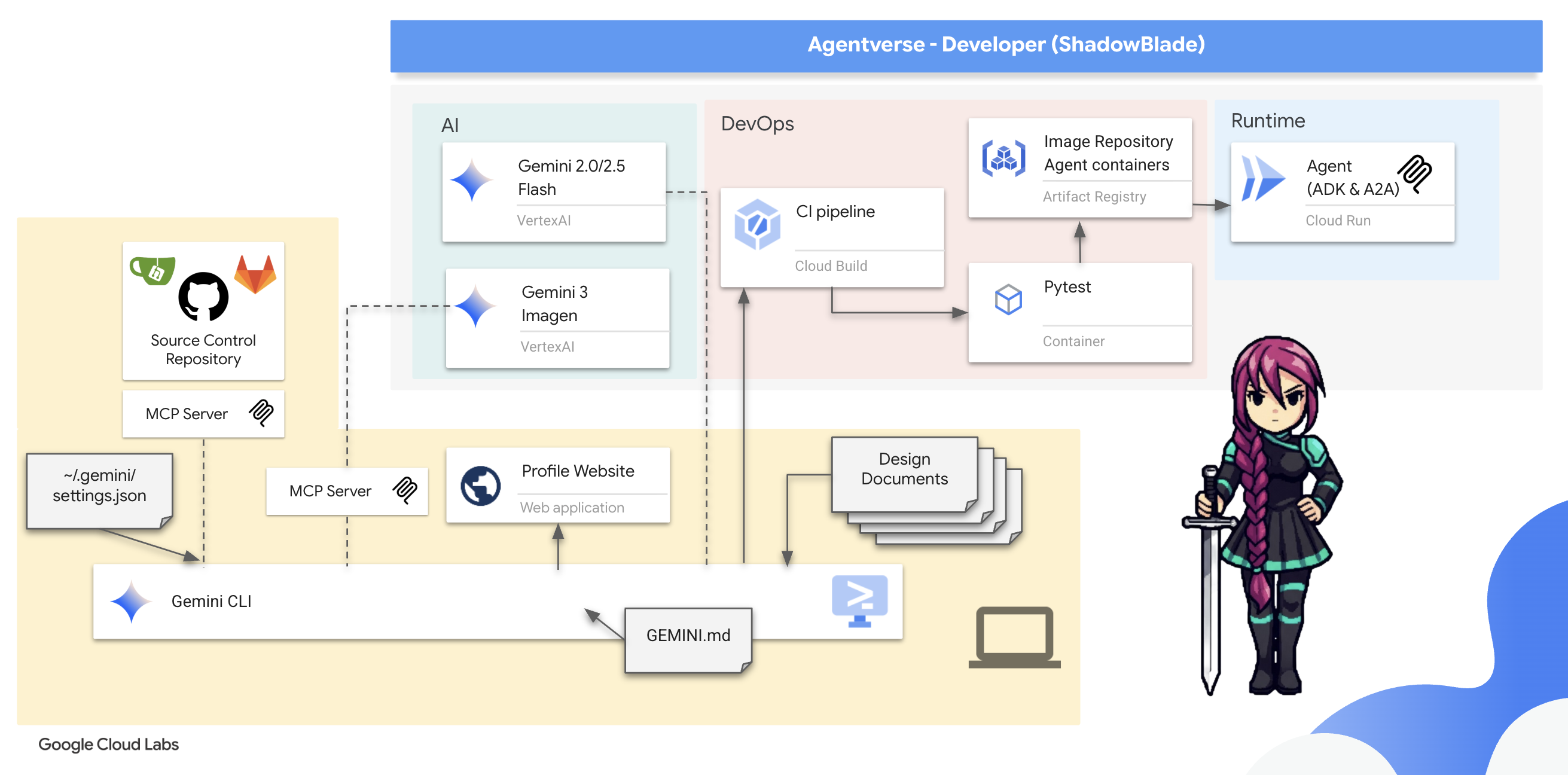
What you'll learn
- Wield your primary weapon: the Gemini CLI.
- Summon external arsenals by integrating MCP tools with the Gemini CLI to analyze unfamiliar codebases.
- Channel your intent into a "Vibe" using design documents to command your AI partner.
- Forge a clean, modular solution by building your first autonomous agent with the Agent Development Kit (ADK).
- Constructing automated evaluation suites to test and validate your agent.
- Build a complete CI pipeline, to automatically test, containerize, and archive your agent.
3. Preparing the Training Ground
👉Click Activate Cloud Shell at the top of the Google Cloud console (It's the terminal shape icon at the top of the Cloud Shell pane), 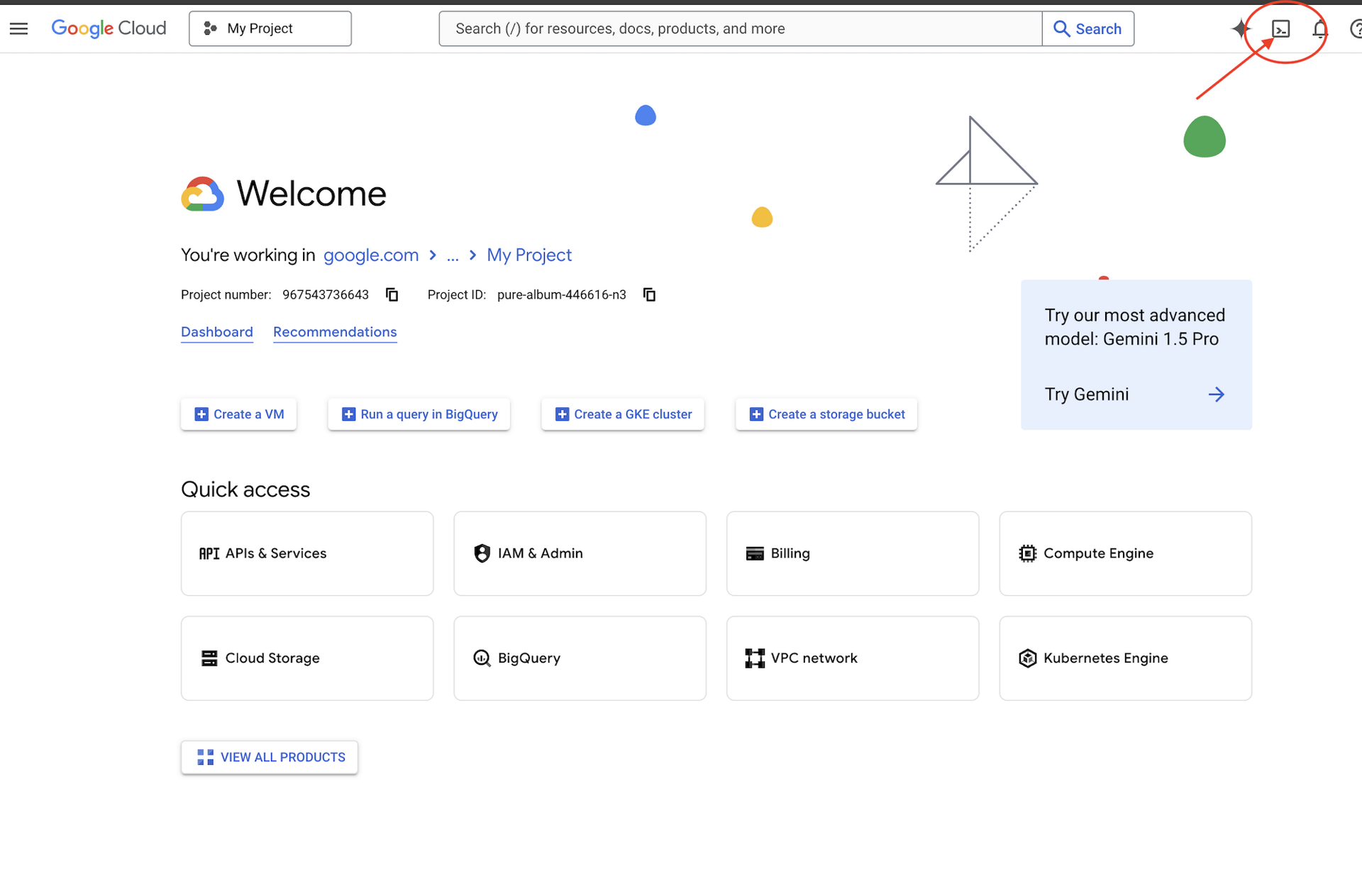
👉Click on the "Open Editor" button (it looks like an open folder with a pencil). This will open the Cloud Shell Code Editor in the window. You'll see a file explorer on the left side. 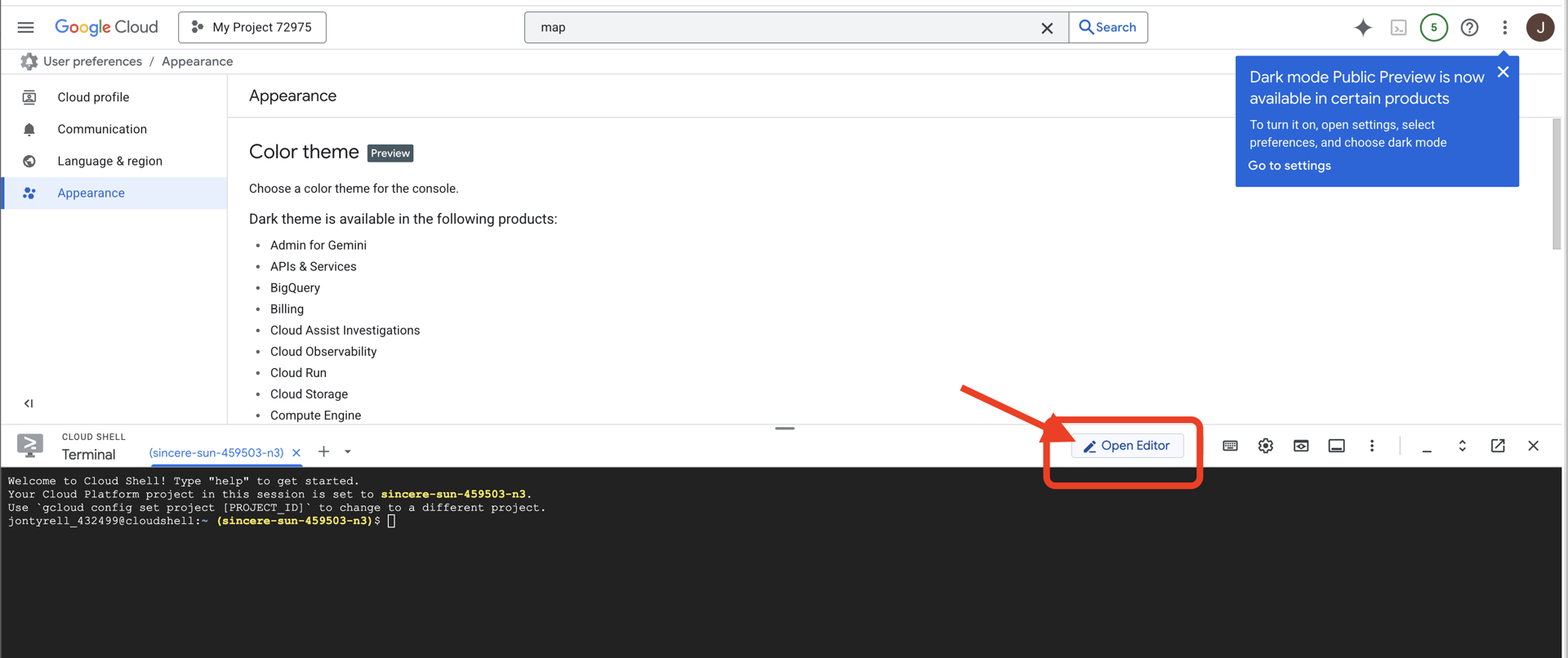
👉Find your Google Cloud Project ID:
- Open the Google Cloud Console: https://console.cloud.google.com
- Select the project you want to use for this workshop from the project dropdown at the top of the page.
- Your Project ID is displayed in the Project info card on the Dashboard
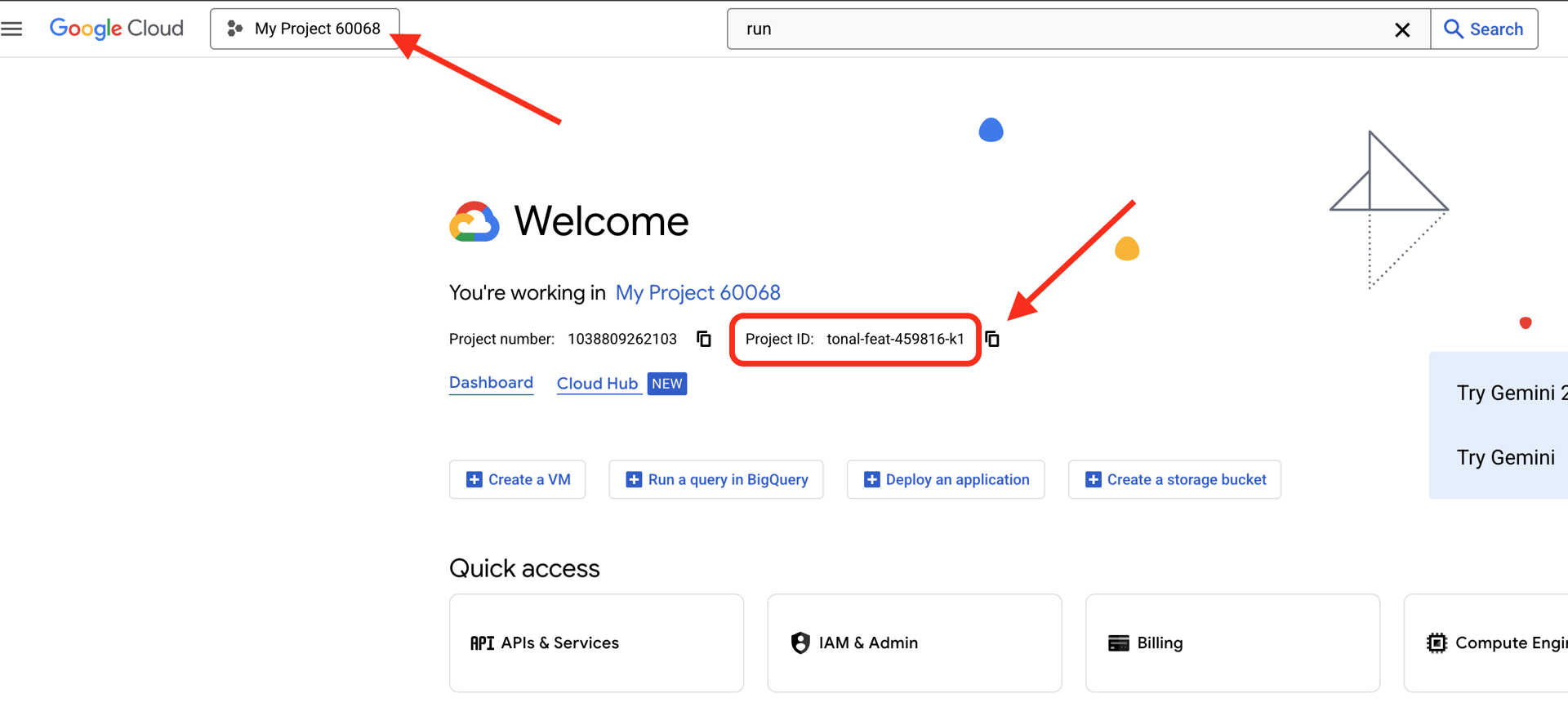
👉Open the terminal in the cloud IDE,
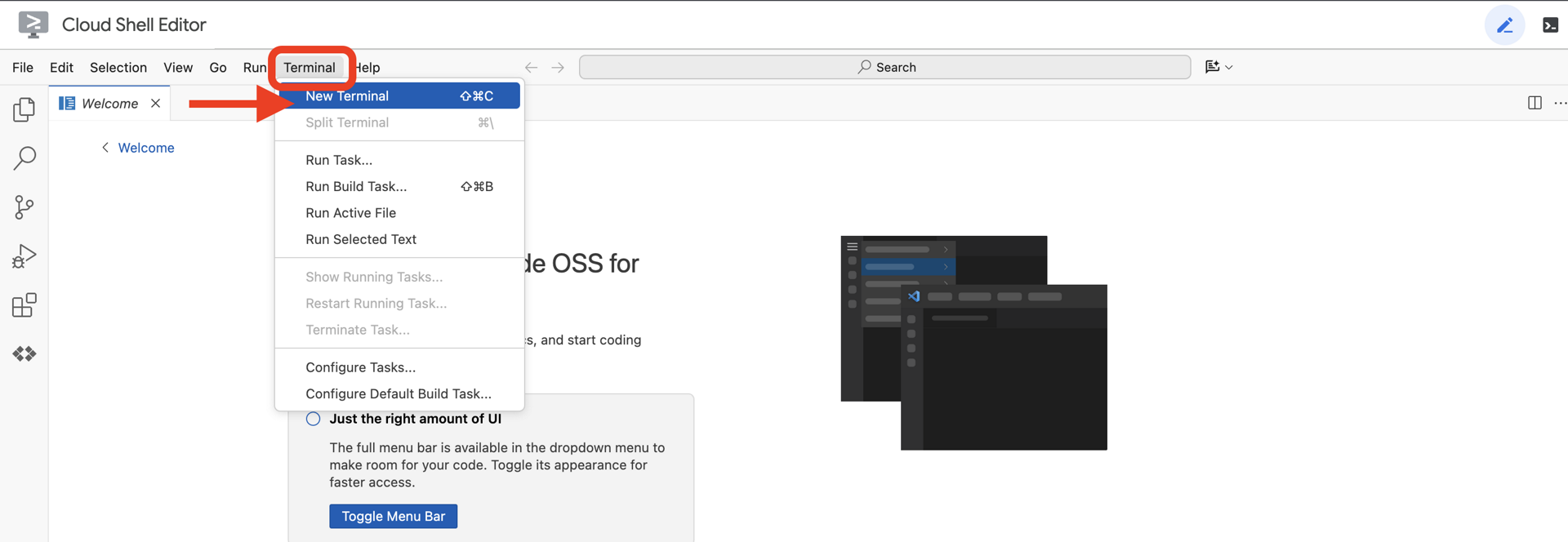
👉💻 In the terminal, verify that you're already authenticated and that the project is set to your project ID using the following command:
gcloud auth list
👉💻 Clone the bootstrap project from GitHub:
git clone https://github.com/weimeilin79/agentverse-developer.git
chmod +x ~/agentverse-developer/gitea.sh
chmod +x ~/agentverse-developer/init.sh
chmod +x ~/agentverse-developer/set_env.sh
git clone https://github.com/weimeilin79/agentverse-dungeon.git
chmod +x ~/agentverse-dungeon/run_cloudbuild.sh
chmod +x ~/agentverse-dungeon/start.sh
git clone https://github.com/weimeilin79/vertex-ai-creative-studio.git
chmod +x ~/vertex-ai-creative-studio/experiments/mcp-genmedia/mcp-genmedia-go/install.sh
👉💻 Run the initialization script, this script will prompt you to enter your Google Cloud Project ID. And enter Google Cloud Project ID you found from the last step when prompted by the init.sh script.
cd ~/agentverse-developer
./init.sh
👉💻 Set the Project ID needed:
gcloud config set project $(cat ~/project_id.txt) --quiet
👉💻 Run the following command to enable the necessary Google Cloud APIs:
gcloud services enable compute.googleapis.com \
artifactregistry.googleapis.com \
run.googleapis.com \
cloudfunctions.googleapis.com \
cloudbuild.googleapis.com \
iam.googleapis.com \
aiplatform.googleapis.com \
cloudresourcemanager.googleapis.com
👉💻 If you have not already created an Artifact Registry repository named agentverse-repo, run the following command to create it:
. ~/agentverse-developer/set_env.sh
gcloud artifacts repositories create $REPO_NAME \
--repository-format=docker \
--location=$REGION \
--description="Repository for Agentverse agents"
Setting up permission
👉💻 Grant the necessary permissions by running the following commands in the terminal: :
. ~/agentverse-developer/set_env.sh
# Artifact Registry Admin
gcloud projects add-iam-policy-binding $PROJECT_ID \
--member="serviceAccount:$SERVICE_ACCOUNT_NAME" \
--role="roles/artifactregistry.admin"
# Cloud Build Editor
gcloud projects add-iam-policy-binding $PROJECT_ID \
--member="serviceAccount:$SERVICE_ACCOUNT_NAME" \
--role="roles/cloudbuild.builds.editor"
# Cloud Run Admin
gcloud projects add-iam-policy-binding $PROJECT_ID \
--member="serviceAccount:$SERVICE_ACCOUNT_NAME" \
--role="roles/run.admin"
# IAM Service Account User
gcloud projects add-iam-policy-binding $PROJECT_ID \
--member="serviceAccount:$SERVICE_ACCOUNT_NAME" \
--role="roles/iam.serviceAccountUser"
# Vertex AI User
gcloud projects add-iam-policy-binding $PROJECT_ID \
--member="serviceAccount:$SERVICE_ACCOUNT_NAME" \
--role="roles/aiplatform.user"
# Logging Writer (to allow writing logs)
gcloud projects add-iam-policy-binding $PROJECT_ID \
--member="serviceAccount:$SERVICE_ACCOUNT_NAME" \
--role="roles/logging.logWriter"
gcloud projects add-iam-policy-binding $PROJECT_ID \
--member="serviceAccount:$SERVICE_ACCOUNT_NAME" \
--role="roles/logging.viewer"
👉💻 As you begin your training, we will prepare the final challenge. The following commands summon the Spectres from the chaotic static, creating the bosses for your test.
. ~/agentverse-developer/set_env.sh
cd ~/agentverse-dungeon
./run_cloudbuild.sh
npm update -g @google/gemini-cli
4. Mastering Your Primary Weapon: Intro to Gemini CLI
Before you can wield the advanced, specialized weapons from the MCP server's arsenal, you must first master your primary weapon: the Gemini CLI. This is your most versatile blade, capable of shaping the digital world with your commands. These drills will familiarize you with its fundamental handling and capabilities.
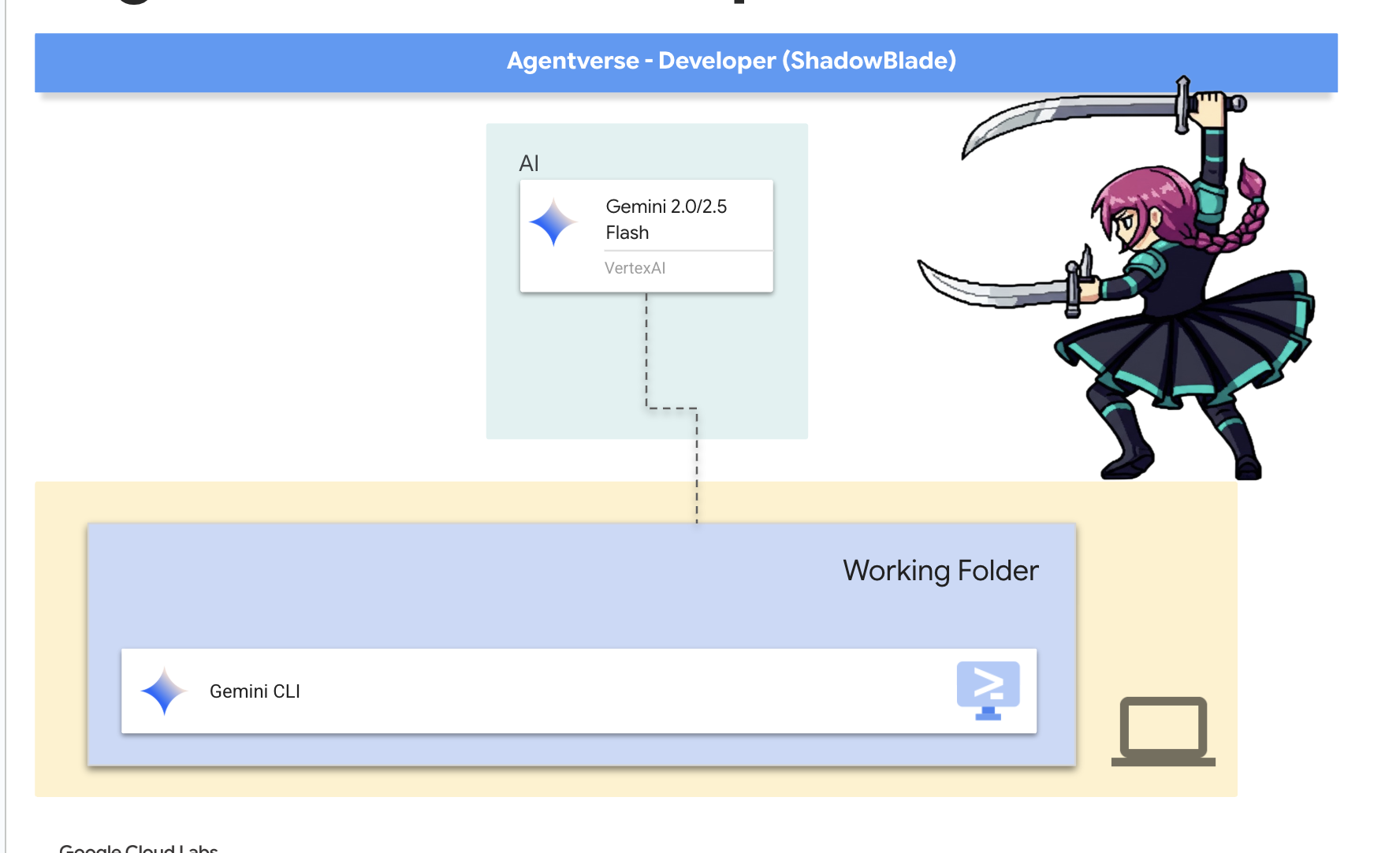
The Gemini Command Line Interface (CLI) is more than a tool; it is an extension of your will. This open-source AI agent, powered by Gemini models, operates on a "reason and act" (ReAct) loop. It analyzes your intent, selects the proper technique, executes it, and observes the result to complete complex tasks. Before you can wield more specialized weapons, you must master this primary blade.
Getting started with Gemini CLI
👉💻 Enter the training grounds and draw your weapon. In your Cloud Shell terminal, navigate to your personal armory.
cd ~/agentverse-developer
mkdir tabletop
cd tabletop
👉💻 Summon Gemini for the first time. It will guide you through the initial attunement.
clear
gemini --model=gemini-2.5-flash --yolo
If it ask you Do you want to connect Cloud Shell editor to Gemini CLI?, choose NO.
Weapon Familiarization
Every master craftsman knows their tools. You must learn the core techniques of your blade before facing a true enemy.
👉✨ Every enchanted tool has runes that describe its power. Read them now. In the Gemini prompt, type:
/help
Observe the list of commands. These are your fundamental techniques for managing memory (focus), conversation (chat), and external arsenals (tools). This is your combat manual.
👉✨ Your weapon is attuned to its environment, allowing you to manipulate the battlefield directly. Issue a command to the world outside the blade:
!ls -l
👉✨ The Gemini CLI possesses its own set of built-in abilities. To inspect them:
/tools
You'll see a list including ReadFile, WriteFile, and GoogleSearch. These are the default techniques you can call upon without needing to draw from an external arsenal.
👉✨ A weapon is only effective if properly focused. The Gemini Blade can hold "tactical awareness" (context) to guide its actions.
/memory show
It is currently empty, a blank slate.
👉✨ Inscribe the following tactical data into its memory:
/memory add "The Shadowblade's primary foe is The Static."
Run /memory show again to confirm your blade has absorbed this knowledge.
👉✨ To be effective, your weapon must understand the mission. The @ sigil commands the blade to analyze intel. First, create a mission briefing file:
!echo "## Mission Objective: Defeat the Seven Spectres" > mission.md
👉✨Now, command your Gemini CLI to analyze the briefing and report its findings:
Explain the contents of the file @mission.md
Your primary weapon is now aware of its objective.
👉💻 Press Ctrl+C twice to exit the Gemini CLI
5. Analyzing the Battlefield: Practical Vibe Coding Interaction
The training drills are complete. You have learned the basic stances and strikes of your primary weapon, the Gemini CLI. But a blade is not truly mastered until it has been tested in the forge of creation and attuned to the armory of war. Before you can face the true enemy, you must first survey and shape your immediate surroundings—the digital battlefield.
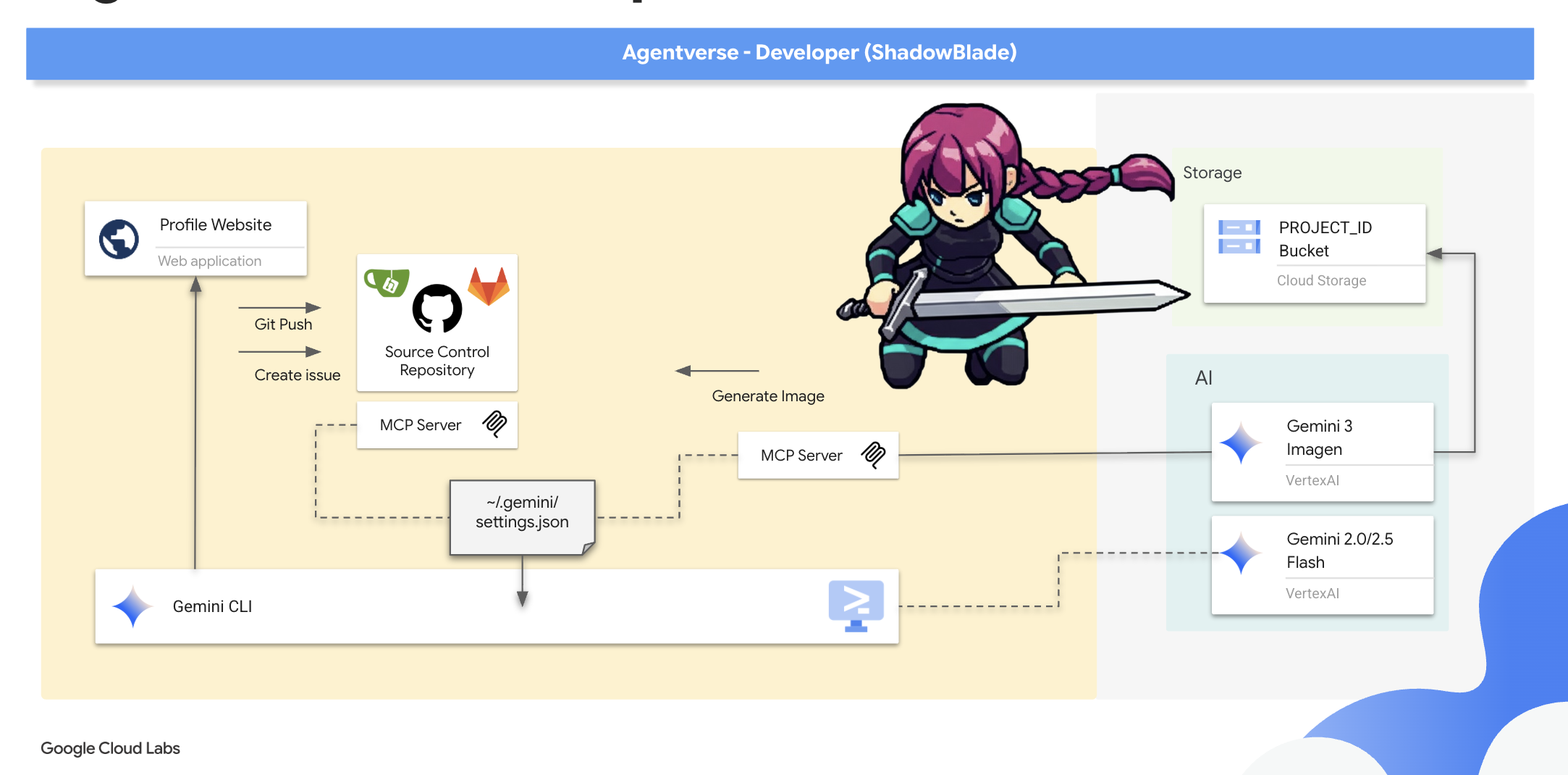
This chapter is about moving from theory to practice. You will first establish your presence in the Agentverse by commanding your Gemini blade to forge your Maker's Mark—a digital signature in the form of a personal website, built from nothing but your intent. Then, you will expand your power by activating a local arsenal of advanced tools—an MCP server—and attuning your blade to its frequency, allowing you to perform complex maneuvers like managing code repositories with simple, decisive commands.
Establishing Your Maker's Mark
A true Shadowblade is recognized not just by their weapon, but by their signature style—their Maker's Mark. This mark will be your digital presence, a personal profile that announces your identity to the Agentverse. Here, you will command your Gemini Blade to execute the complex technique required to define this identity.
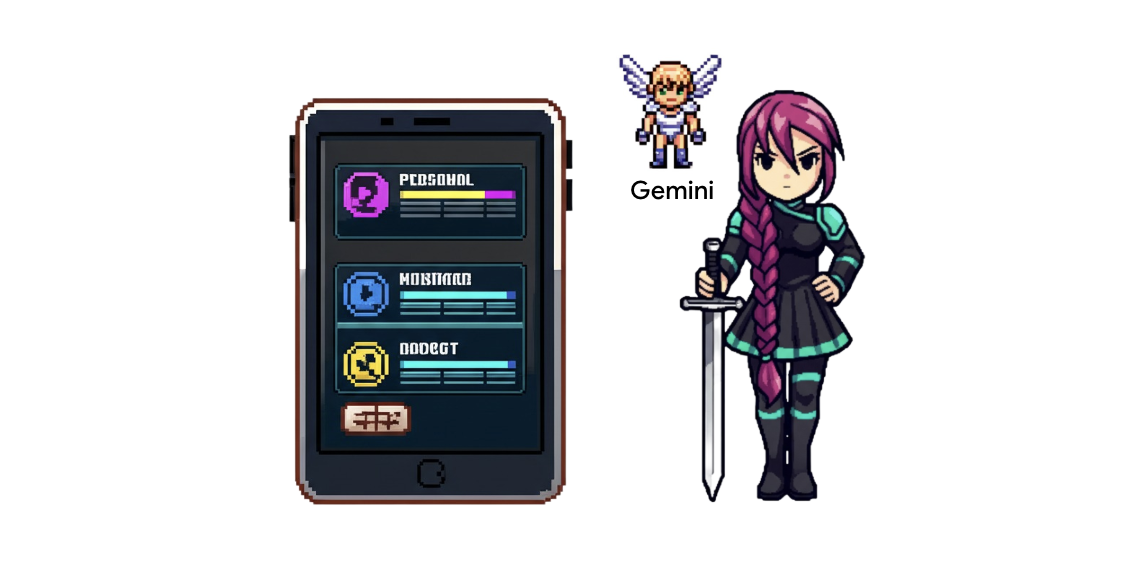
👉💻 If you closed the Gemini CLI, in the previous section, make sure to start it again, in you terminal run
clear
cd ~/agentverse-developer/tabletop
gemini --model=gemini-2.5-flash --yolo
👉✨ With a single, powerful command, instruct your Gemini CLI to forge the foundation of your digital identity:
In the current folder, create a personal profile website for a hero codenamed 'Shadowblade'. The design must be a dark, futuristic theme with electric blue accents. All code must be in separate index.html and styles.css files. The layout must use CSS Flexbox for a two-column design. All generated code must be clean, well-commented, and professional.
Gemini has calculated the sequence of actions required.
A technique's true value is only seen in a live scenario. Command your blade to initiate a local simulation.
👉✨ In your Gemini CLI, issue the simulation command:
Use Python's built-in web server to start the Shadowblade Profile website you just created.
Note: The blade may need a few attempts to execute this correctly. Persist until it obeys.
Agree to the suggested actions. Gemini will confirm the simulation is active.
👀 Gemini CLI will obey, confirming that the simulation is active and your digital mark is live:
The website is now being served on port 8000. You can access it at http://localhost:8000.
👀 To gaze upon your work, click the Web preview icon in the Cloud Shell toolbar. Select Change port, set it to 8000, and click Change and Preview. A preview of your website will appear. 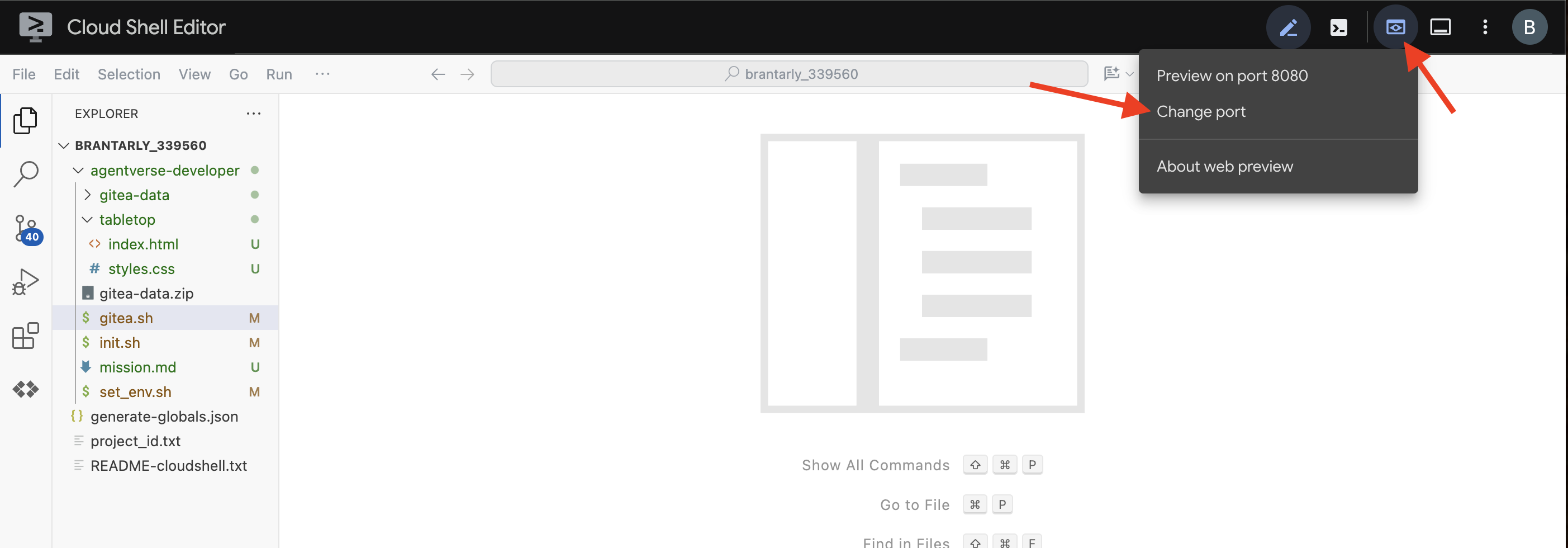
Your website might look different from mine. This is your unique mark. 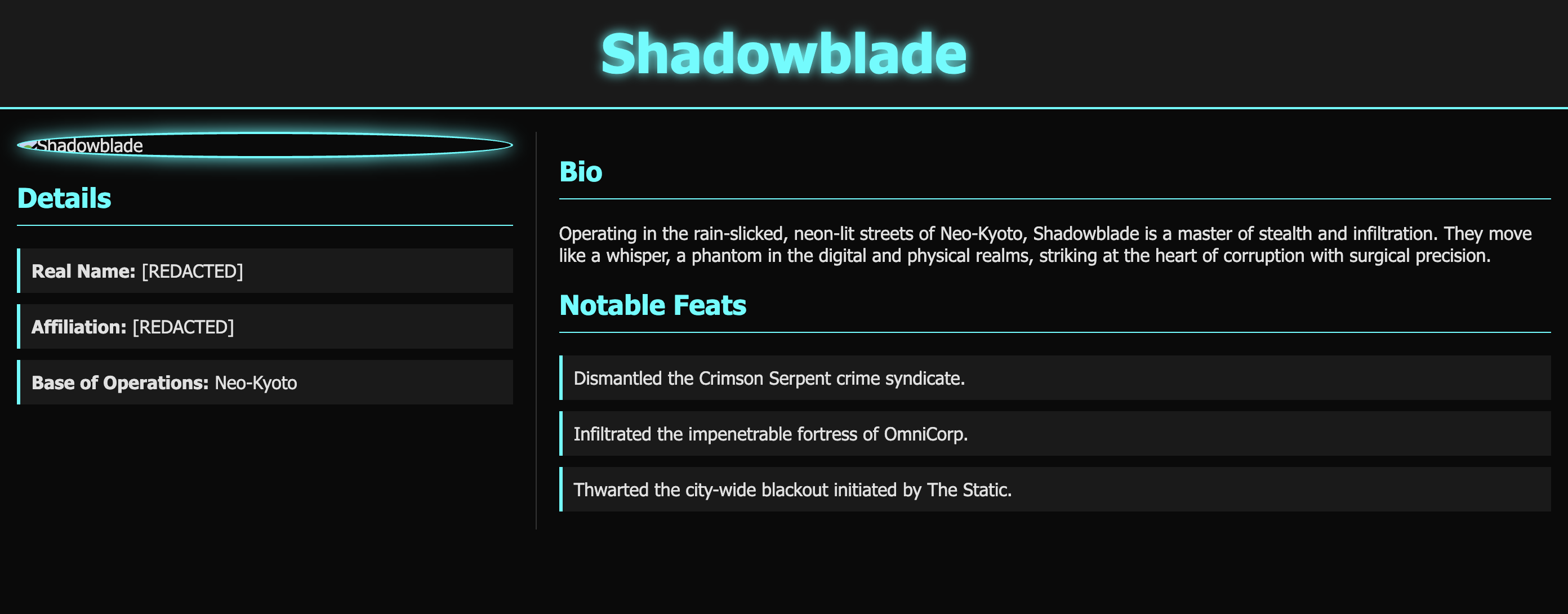
👉✨ Your signature technique is now refined, and the live simulation is no longer required. Command the Blade to stand down.
Stop the Shadowblade Profile website
You have successfully commanded the Gemini CLI to execute a series of actions on your behalf. But a master Shadowblade knows that true power requires discipline and foresight. Allowing an AI agent to execute commands directly in your environment is a double-edged sword. What if the command was not to start a simple web server, but to delete critical files? A careless command could lay waste to your entire training ground.
This is why the wisest artisans practice their most powerful or untested techniques within a warded training ground—a contained dimension known as the sandbox.
👉💻 Press Ctrl+C twice to exit the Gemini CLI
The Gemini CLI sandbox (gemini --sandbox) creates a temporary, isolated container for your session. Any command the AI executes, any file it writes, any process it starts, exists only within that phantom realm. It cannot touch, alter, or damage your actual Cloud Shell environment. It is the perfect place to test powerful new tools, analyze unfamiliar code, or give the AI complex instructions without risking unintended consequences. It is the embodiment of a Shadowblade's caution.
👉💻 Now, you will perform a ritual of containment to understand its power.
clear
gemini --sandbox --yolo
You are now operating within the isolated dimension. To the Gemini CLI, everything will seem normal. Let's prove it. 👉💻 Command the blade to perform the exact same technique as before:
Use the Python's built-in web server to start the Shadowblade Profile website, you just created.
Gemini will report success, believing it has once again brought your website to life on port 8000. But the ward holds strong.
👉 Go to the Web preview and attempt to view your site on port 8000.
This time, you will be met with an error. The connection will fail. You cannot access the website.
This is not a failure of the tool, but proof of the sandbox's power. The web server is running, but it is running inside the contained dimension, completely isolated from your browser and the outside world. The ward is working perfectly. You have successfully wielded a powerful technique in a way that had zero impact on your actual environment.
👉💻 Press Ctrl+C twice to exit the Gemini CLI.
Your digital identity is now established, and more importantly, you have learned the critical wisdom of wielding great power with even greater caution.
Activate Your Local Arsenal: The Gitea Armory
A Shadowblade's true potential is unlocked not just by their personal skill, but by the quality of their arsenal. You will now activate your local weapons rack—a Gitea server—and attune your blade to its power. This arsenal is connected to your Gemini CLI through a Model Context Protocol (MCP) server, a specialized portal that allows your AI blade to interact with external tools and services, transforming your terminal into an intelligent, action-oriented workspace.
Developer's Note: Think of an MCP server as a conduit of power, a specialized portal that connects your AI's mind to an external tool's body. It's what elevates the Gemini CLI from a mere conversationalist into a true, action-oriented agent. By attuning your blade to these MCP portals, you grant it the ability to perform tangible actions: to manage files, query databases, interact with APIs, and much more. An entire ecosystem of these portals exists, created by developers to connect AI agents to powerful platforms. There are MCP servers for interacting with databases, securing code, or even support for pair programming. The possibilities are vast, allowing a developer to customize their workspace for any given projects.
Today, we will focus on two fundamental powers essential to any "vibe coder": the power to control the forge and the power to create from imagination. You will first attune your blade to a Git server, granting you command over your source code repository. Then, you will connect to a second MCP server for image generation, allowing you to create visual assets with nothing more than a command.
Let us begin by summoning the first and most fundamental piece of your new arsenal: the armory itself.
👉💻 In your terminal, execute the activation script to summon the armory:
cd ~/agentverse-developer
./gitea.sh
This script awakens the Gitea container and opens the MCP portal, allowing Gemini to perceive and interact with it.
👉 To inspect your new arsenal, you must gaze into the web preview.
👉 From the Web preview icon in the Cloud Shell toolbar, select Change port and set it to 3005. 
👉 A Gitea login page will appear. Enter the armory using the incantation: * Username: dev * Password: dev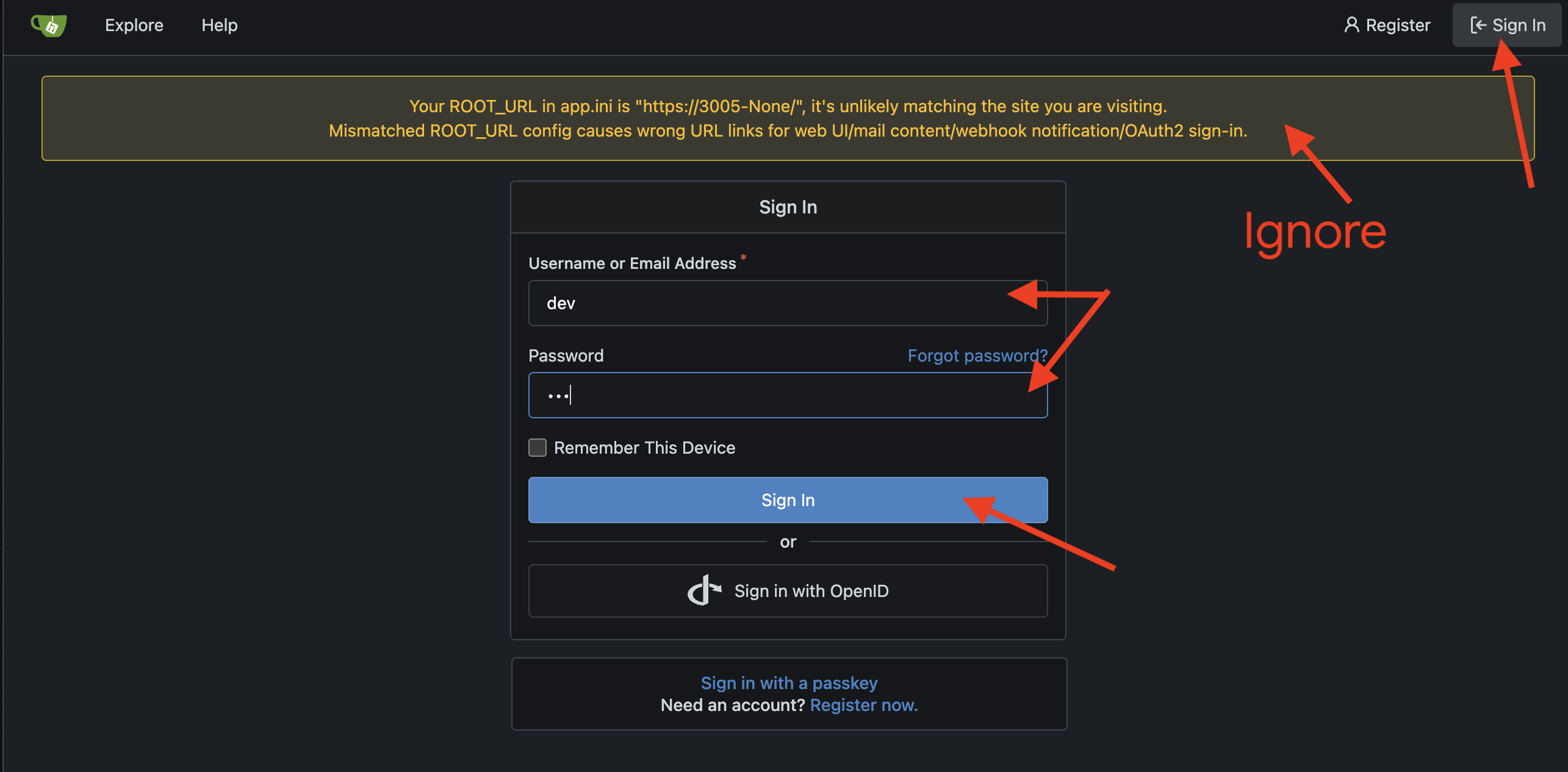
👉💻 Your Gemini CLI cannot yet see this new arsenal. You must perform a critical attunement, inscribing the armory's location onto the Gemini CLI's configuration runes (settings.json). In your terminal, run:
jq '. * {"mcpServers":{"gitea":{"url":"http://localhost:8085/sse"}}}' ~/.gemini/settings.json > tmp.json && mv tmp.json ~/.gemini/settings.json
cat ~/.gemini/settings.json
👀 The settings.json file is the central configuration for the Gemini CLI, acting as its grimoire of preferences and capabilities. It dictates how the CLI behaves, appears, and, most importantly, what external powers it can wield. This file is typically located in your home directory at ~/.gemini/settings.json, applying its rules to all your projects. However, you can also create project-specific settings.json files within a .gemini directory inside your project folder to override the global settings.
"mcpServers": {
"gitea": {
"url": "http://localhost:8085/sse"
}
}
This setting tells your Gemini, "The arsenal named gitea is active and listening for commands at this specific network address."
👉💻 Re-enter the Gemini CLI. In your terminal, run:
clear
cd ~/agentverse-developer/tabletop/
gemini --model=gemini-2.5-flash --yolo
👉✨ Verify that your blade has discovered the new weapon. Command it to list all available arsenals through its MCP portals:
/mcp
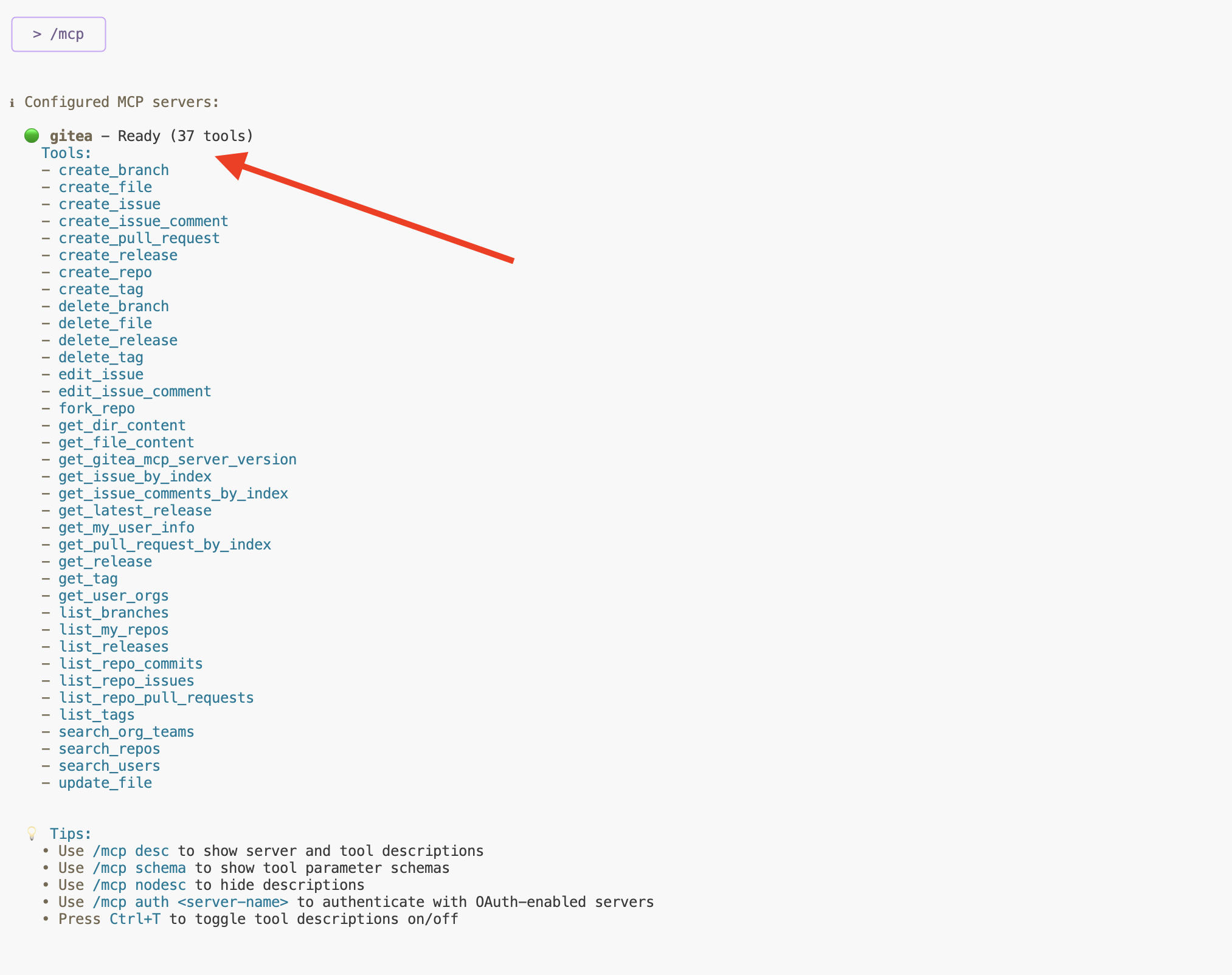
You should now see gitea and its list of available techniques. Your blade is attuned.
Your "Maker's Mark" profile is a finely crafted technique, but it needs a proper place in the armory—a scabbard to hold it securely. Command your Gemini CLI to create one.
Create a new repository named 'shadowblade-profile'. The description should be 'The Maker's Mark and digital identity for the Shadowblade operative.' I will push my own files later, so do not create any content.
Return to the Gitea web interface and refresh. You will see the new shadowblade-profile repository has been forged for you. 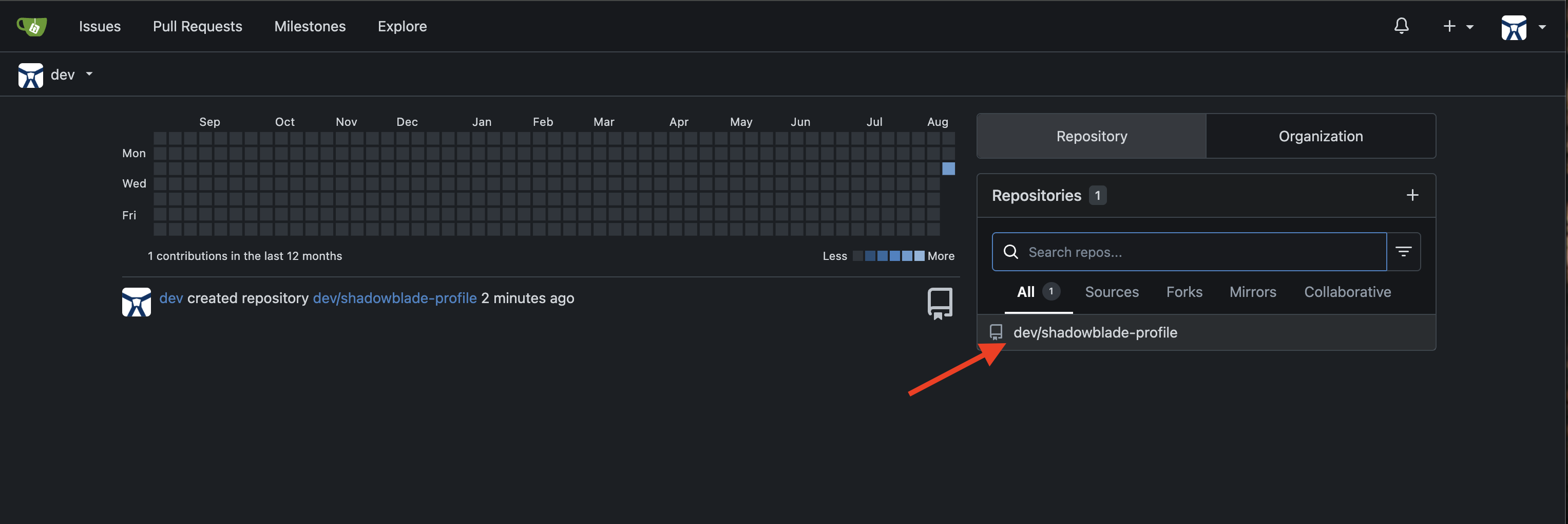
With the scabbard ready, secure your work. Command Gemini to commit the files of your profile website.
👉💻Issue the final command for this technique in Gemini CLI:
Using the Gitea tool, push the index.html and styles.css files to the 'shadowblade-profile' repository.
A true master verifies their work. Return to the Gitea tab and refresh the repository page. Your index.html and styles.css are now safely archived.
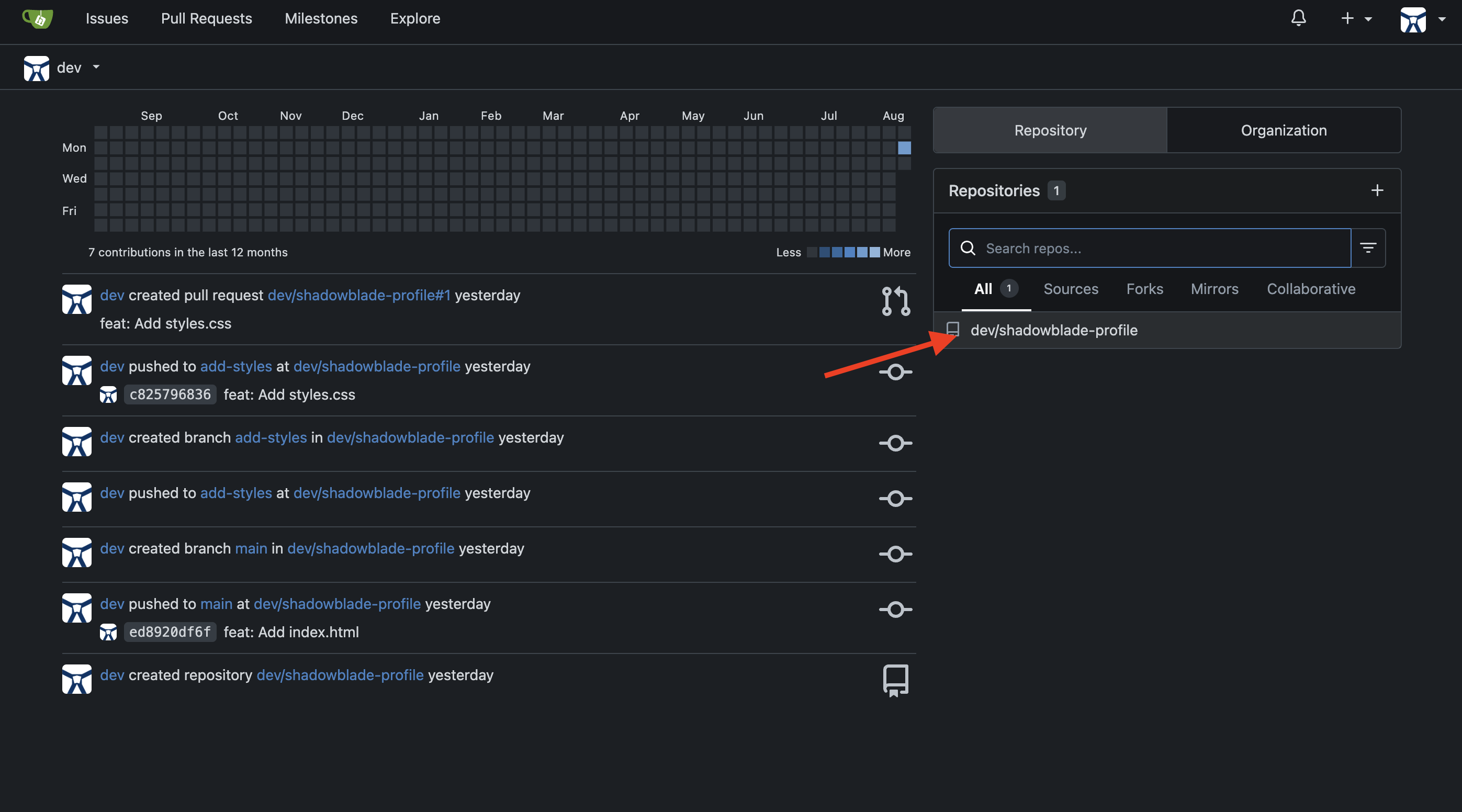
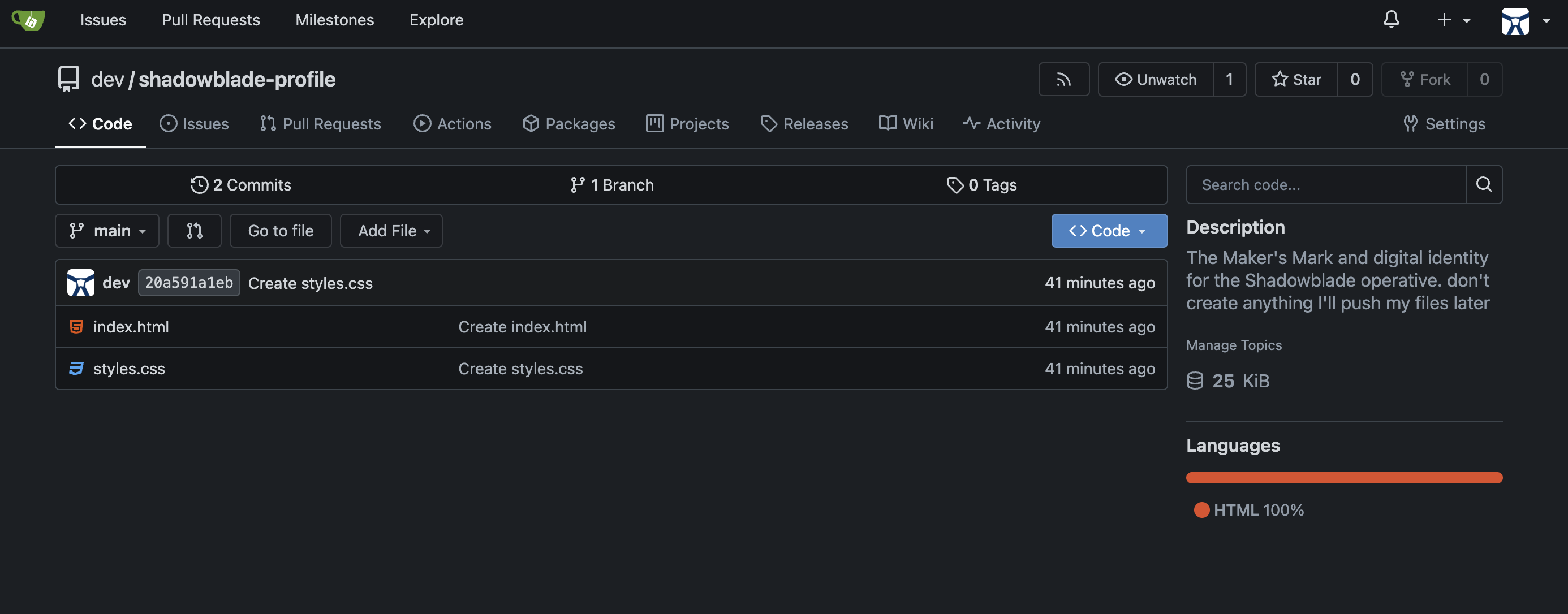
👉✨ A Shadowblade is defined by their sigil, but as you recall, your website is missing its profile image. A master artisan acknowledges their flaws in order to perfect them. You must log this imperfection in the armory's records.
File an issue for me in the shadowblade-profile repo. The issue is that the profile image is missing.
View the issue in Gitea 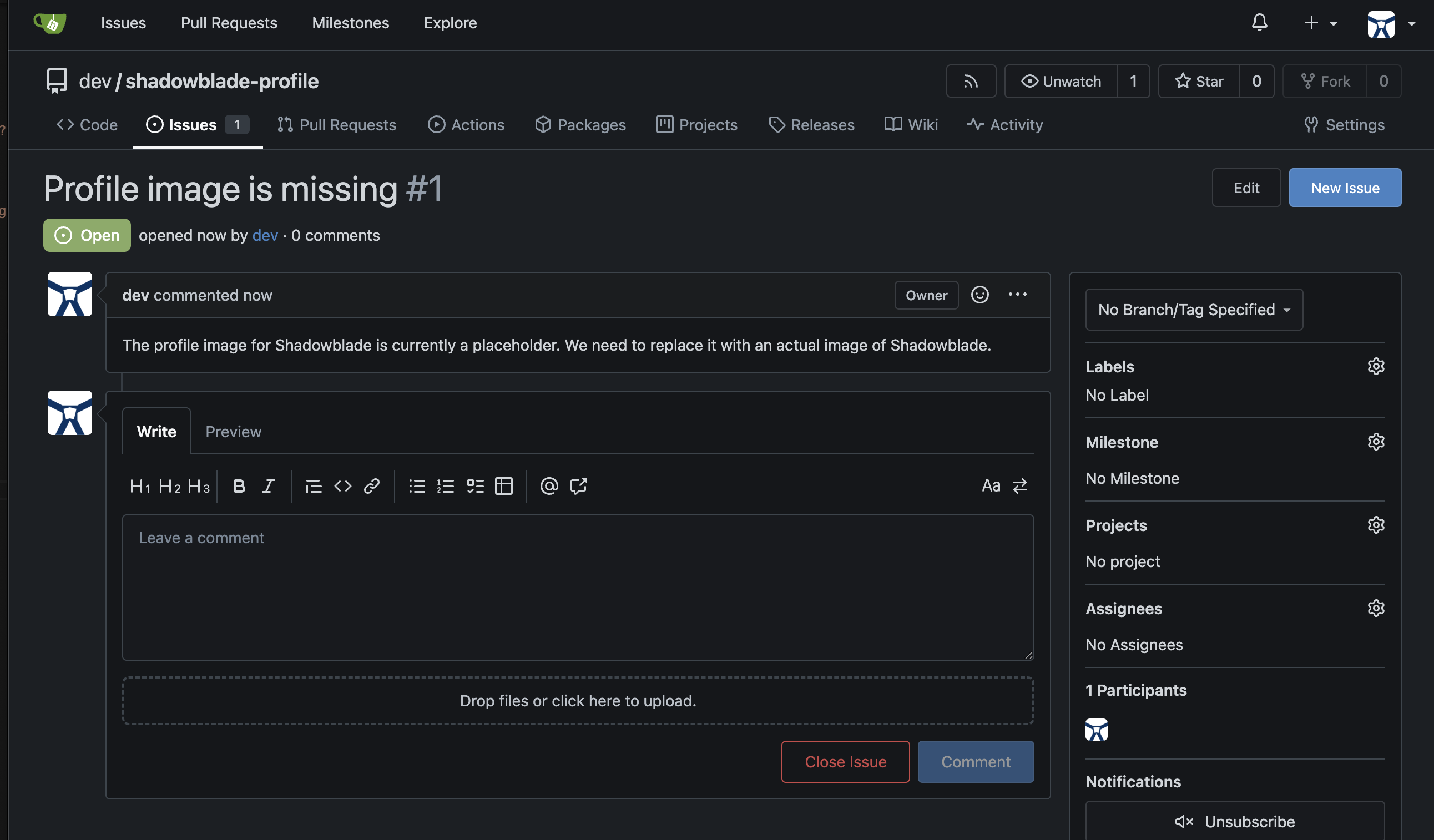
To forge the missing sigil, you must summon a different kind of power—a creation spirit from Vertex AI capable of generating imagery from pure thought. This requires another MCP portal.
👉💻 Press Ctrl+C twice to exit the Gemini CLI
👉💻 First, install the portal's server. In your terminal, run:
echo 'export PATH="$PATH:$HOME/go/bin"' >> ~/.bashrc
source ~/.bashrc
cd ~/vertex-ai-creative-studio/experiments/mcp-genmedia/mcp-genmedia-go
./install.sh
👉 When prompted, choose option 3, as we only need to generate an image for our profile.
👉💻 The creation spirit requires a sacred vessel—a Google Cloud Storage bucket—to hold its creations. Let's forge one now. In your terminal, run:
. ~/agentverse-developer/set_env.sh
gcloud storage buckets create gs://$BUCKET_NAME --project=$PROJECT_ID
👉💻 Now, perform the attunement ritual, linking your Gemini CLI to this new creative force. In your terminal, run:
. ~/agentverse-developer/set_env.sh
source ~/.bashrc
jq \
--arg bucket "$BUCKET_NAME" \
--arg project "$PROJECT_ID" \
--arg region "$REGION" \
'.mcpServers.imagen = { "command": "mcp-imagen-go", "env": { "MCP_SERVER_REQUEST_TIMEOUT": "55000", "GENMEDIA_BUCKET": $bucket, "PROJECT_ID": $project, "LOCATION": $region } }' \
~/.gemini/settings.json > tmp.json && mv tmp.json ~/.gemini/settings.json
cat ~/.gemini/settings.json
This "attunement ritual" is a shell script that configures your Gemini CLI to use a powerful new tool: Imagen, Google's image generation model. Crucially, it achieves this by setting up an MCP (Model Context Protocol) server for Imagen. This MCP server acts as a bridge, enabling the Gemini CLI to communicate with and utilize Imagen's capabilities. It does this by directly modifying the CLI's central configuration file, ~/.gemini/settings.json, to teach it how to run the mcp-imagen-go command with the correct cloud credentials.
👀 After the ritual, your settings.json has a new block that teaches Gemini CLI a new skill:
"imagen": {
"command": "mcp-imagen-go",
"env": {
"MCP_SERVER_REQUEST_TIMEOUT": "55000",
"GENMEDIA_BUCKET": "your-bucket-name",
"PROJECT_ID": "your-project-id",
"LOCATION": "your-region"
}
}
This tells the Gemini CLI: "When a task requires the Imagen tool, you must execute the program named mcp-imagen-go (which is the Imagen MCP server). When you run it, you must provide it with this specific environment (env): a Google Cloud Storage bucket to save the images to, and the project ID and location to use for the cloud APIs." By configuring this MCP server, you're effectively equipping the Gemini CLI with access to Imagen's image generation power."
👉💻 Enter Gemini and issue the refinement command. In your terminal, run:
clear
cd ~/agentverse-developer/tabletop/
gemini --model=gemini-2.5-flash --yolo
👉✨ With a single, powerful command, instruct your Gemini CLI to build the foundation for your digital identity. In your Gemini CLI, issue the command:
Generate a portrait of a shadowblade, pixel art style. A determined warrior with long, braided magenta hair, wearing black and teal armor and confidently holding a silver broadsword.
👉✨ The spirit will generate the image and place it in your sacred vessel. Now, command the blade to use this newly forged sigil.
Modify the index.html file to add my profile picture. Use the image I just generated.
👉✨ Start the website one last time to behold your perfected work.
start the website with a simple HTTP server via Python
👀 To gaze upon your work, click the Web preview icon in the Cloud Shell toolbar. Select Change port, set it to 8000, and click Change and Preview. A preview of your website will appear. 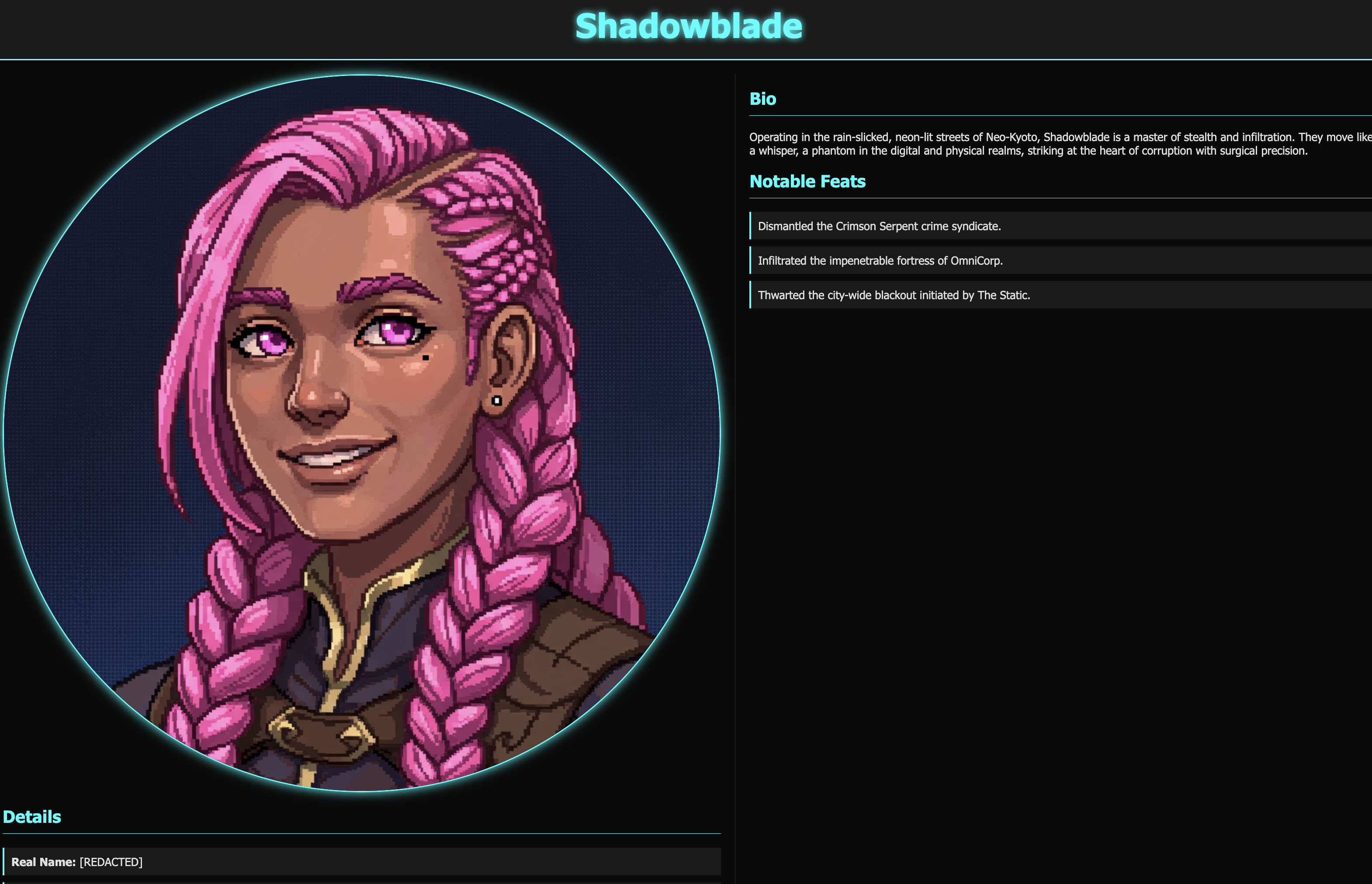
👉✨ Finally, commit the fix, noting the completion of the task, and close the issue you filed in the armory's records.
Push the changed index.html file to the 'shadowblade-profile' repository using the gitea tool. Make sure you add 'Fix #1' in the commit comment. Also, close issue #1.Use the Gitea Tool and use user account "dev"
👀 To gaze upon your work, click the Web preview icon in the Cloud Shell toolbar. Select Change port, set it to 3005, and click Change and Preview. A preview of your website will appear. 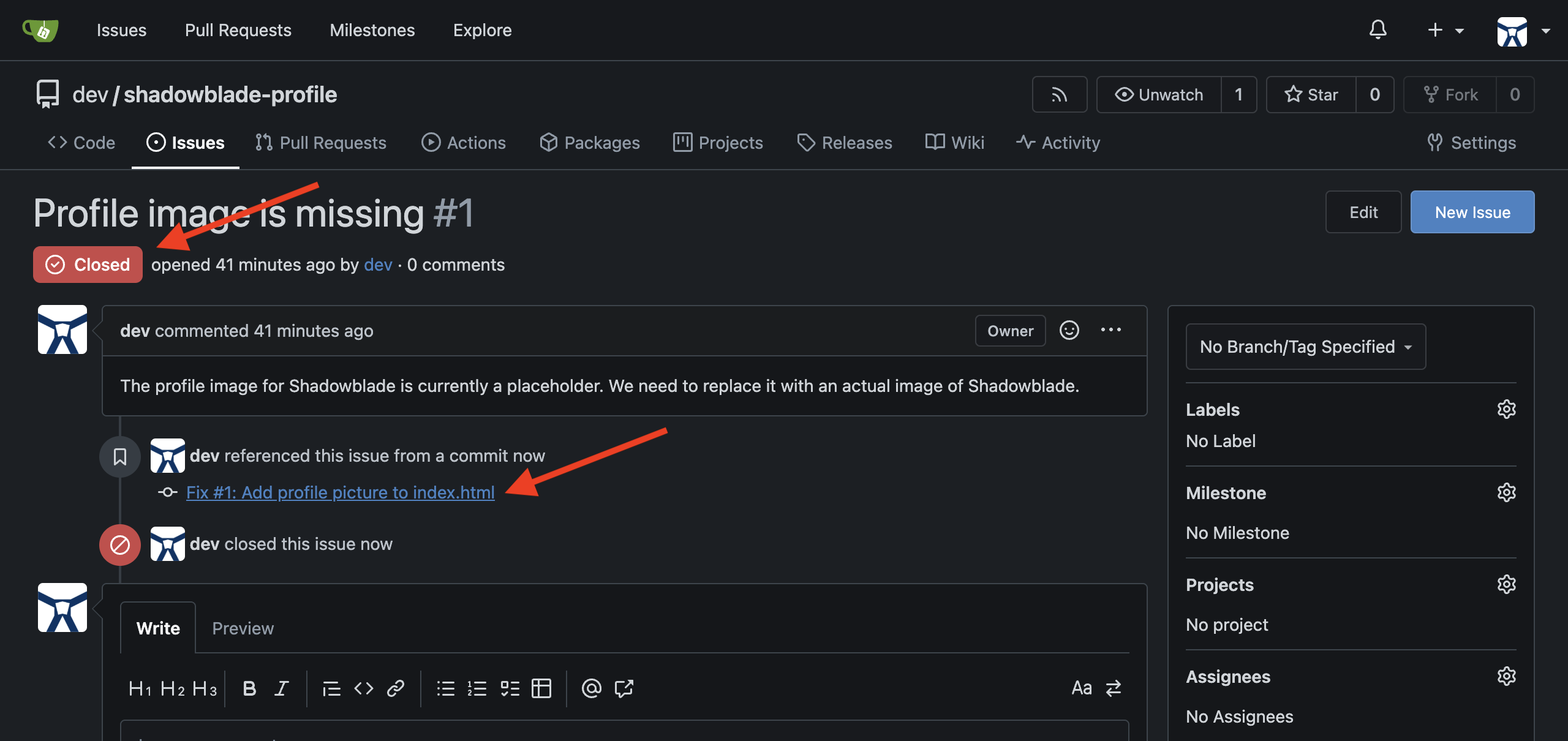
👉✨ Verify in Gitea that the image is updated and the issue is closed. Your work is complete. Stand down the server.
stop website server
👉💻 Press Ctrl+C twice to exit.
FOR NON GAMERS
6. Assembling the Shadowblade Agent: Vibe code with Guardrails
The time for practice drills is over. The echoes of steel on stone fade. You have mastered your primary weapon and prepared your arsenal for war. Now, you will undertake the true test of a Shadowblade: assembling the operative itself. This is the art of breathing life into logic, using a sacred blueprint from the Codex to construct an agent's core intelligence—creating a sentient wielder for the blades in your arsenal that can think, reason, and act on its own.
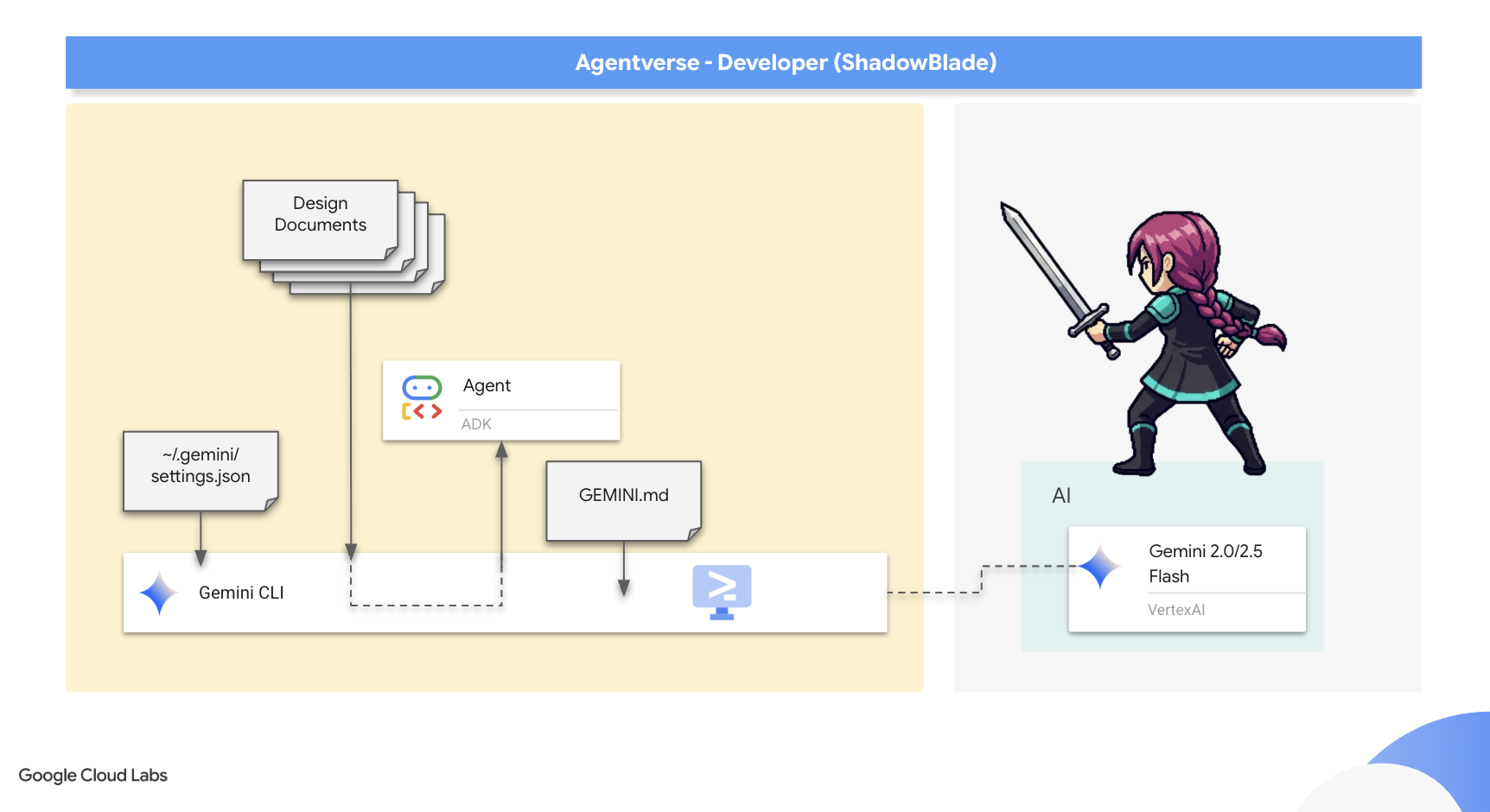
Your first mission is to enter an existing workshop—a pre-built codebase—and from its parts, forge your champion.
The Assembly Ritual
Before the first spark of the forge, a master technician surveys their workshop, understanding every tool and every schematic. When stepping onto an unfamiliar battlefield like a large, existing codebase, your first priority is reconnaissance. You must understand the lay of the land—the existing architecture, the ultimate objectives, and the protocols of engagement. Only by familiarizing yourself with the fortress's blueprints and its standards can you effectively contribute your skill.
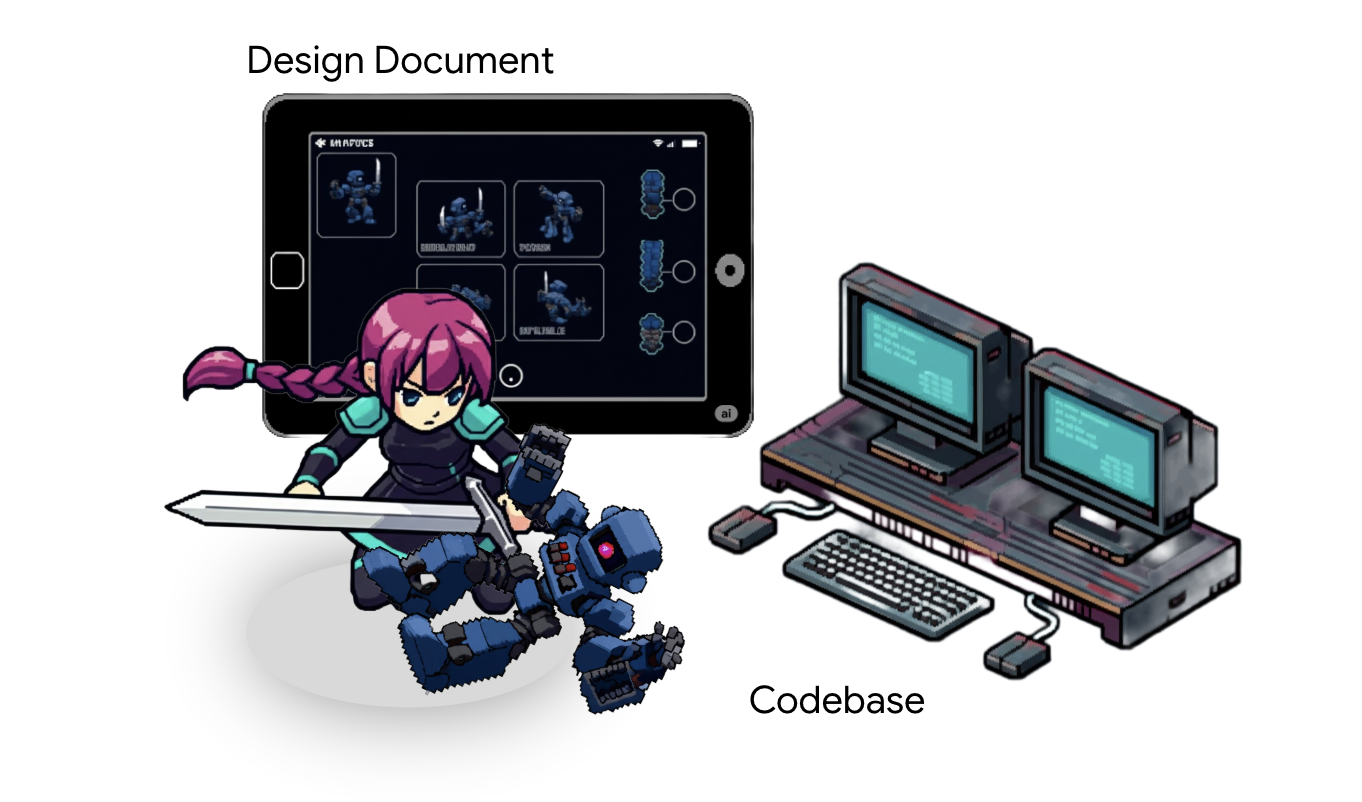
Your Gemini CLI, your ever-present scout, can aid you in this reconnaissance:
- Provide High-Level Summaries: It can read the entire codex (or codebase) and give you a swift understanding of its purpose and key components.
- Help with Environment Setup: It can guide you through the arcane rituals of installing tools and configuring your machine.
- Navigate Codebases: It can act as your guide, helping you explore complex logic and find hidden passages within the code.
- Generate Onboarding Documents: It can create tailored scrolls that clarify goals, roles, and resources for new allies joining your cause.
- Automate Learning and Q&A: It becomes your personal scholar, answering questions about features or code behavior, allowing you to fight with greater independence.
👉💻 In your first terminal, navigate to the shadowblade directory and summon your AI partner:
. ~/agentverse-developer/set_env.sh
cd ~/agentverse-developer/shadowblade
clear
gemini --model=gemini-2.5-flash --yolo
👉✨ Now, command your scout to survey the battlefield and report back.
Analyze the entire project and provide a high-level summary.
With the existing terrain mapped, you must now consult the blueprint for what you are about to build. The most powerful operatives are not improvised, they are constructed from a precise design.
Developer's Note: This design document serves as the authoritative blueprint for the project. Its purpose is to enforce clarity on goals and technical implementation before significant development effort is invested. A well-defined plan ensures all developers are aligned, reduces the risk of rework, and helps prevent technical debt and scope creep. It is the primary tool for maintaining project velocity and code quality, especially as the team grows or new members are onboarded.
A critical goal of this document is to define not just the "happy path" but also the edge cases and failure modes, especially when using LLMs. My experience with LLMs are excellent at generating optimistic code where all inputs are valid and all external calls succeed. To build robust, production-ready software, we must explicitly guide the AI by defining contingencies for scenarios like:
- Invalid or malformed arguments passed to a function.
- API call failures, network timeouts, or unexpected error codes from external services.
- Handling of null or empty data structures where data is expected.
- Race conditions or concurrency issues.
By specifying the expected behavior for these cases in the design, we instruct the LLM to generate more resilient code, significantly reducing the time spent on manual refactoring and bug fixing.
👉✨ Ask Gemini to retrieve this sacred blueprint for you.
download https://raw.githubusercontent.com/weimeilin79/agentverse/main/developer/shadowblade/agent_design.md and store it to my local folder
and show me the newly downloaded design doc. Do not attempt to create file just yet.
👉✨ The scroll is long and detailed. Command Gemini to distill its essence.
Summarize the newly downloaded @agent_design.md for me, do not attempt to create file just yet.
Now you have the plan. But before a single line of code is forged, a master artisan establishes the laws of the forge. This is about discipline and scalability. These are the Coding Guidelines. They are not mere suggestions, they are runes of power that ensure every component is built with the same precision and strength. They prevent the chaos of individual style from corrupting the final creation, ensuring the agent is resilient, maintainable, and pure, allowing new artisans to join the project without disrupting the harmony of the whole.
To inscribe these laws directly into the consciousness of our AI partner, we use a special artifact: the GEMINI.md file. When the Gemini CLI is summoned, it automatically searches for this file and loads its contents into the AI's working memory. It becomes a persistent, project-level instruction. A talisman that constantly whispers the rules of the forge to the AI.
Let's inscribe these runes now.
👉💻 Exit Gemini for a moment by pressing Ctrl+C twice.
👉💻 In your terminal, run the following command to write the guideline file.
cat << 'EOF' > GEMINI.md
### **Coding Guidelines**
**1. Python Best Practices:**
* **Type Hinting:** All function and method signatures should include type hints for arguments and return values.
* **Docstrings:** Every module, class, and function should have a docstring explaining its purpose, arguments, and return value, following a consistent format like reStructuredText or
Google Style.
* **Linter & Formatter:** Use a linter like `ruff` or `pylint` and a code formatter like `black` to enforce a consistent style and catch potential errors.
* **Imports:** Organize imports into three groups: standard library, third-party libraries, and local application imports. Sort them alphabetically within each group.
* **Naming Conventions:**
* `snake_case` for variables, functions, and methods.
* `PascalCase` for classes.
* `UPPER_SNAKE_CASE` for constants.
* **Dependency Management:** All Python dependencies must be listed in a `requirements.txt` file.
**2. Web APIs (FastAPI):**
* **Data Validation:** Use `pydantic` models for request and response data validation.
* **Dependency Injection:** Utilize FastAPI's dependency injection system for managing resources like database connections.
* **Error Handling:** Implement centralized error handling using middleware or exception handlers.
* **Asynchronous Code:** Use `async` and `await` for I/O-bound operations to improve performance.
EOF
cat GEMINI.md
With the laws inscribed, let's re-summon our AI partner and witness the magic of the artifact.
👉💻 Relaunch the Gemini CLI from the shadowblade directory:
. ~/agentverse-developer/set_env.sh
cd ~/agentverse-developer/shadowblade
clear
gemini --model=gemini-2.5-flash --yolo
👉✨ Now, ask Gemini to show you what it's thinking about. The runes have been read.
/memory show
This is the pivotal moment. You will provide the schematic (agent_design.md) and the laws of the forge (GEMINI.md), and issue the great spell of creation.
👉✨ This is the single, powerful command that will construct your agent. Issue it now:
You are an expert Python developer specializing in the Google Agent Development Kit (ADK). Your task is to write the complete, production-quality code for `agent.py` by following the technical specifications outlined in the provided design document verbatim.
Analyze the design document at `@agent_design.md` and generate the corresponding Python code for `@agent.py`.
Ensure the generated code is clean, matches the specifications exactly, and includes all specified imports, functions, and logic. Do not add any extra functions or logic not described in the document.
and you are currently already in the shadowblade working directory
👀 Gemini has now constructed the agent's core logic in agent.py. The core of this new file defines the agent's intelligence, connecting its reasoning model to a set of external tools:
PATH_TO_MCP_SERVER = "shadowblade/mcp_server.py"
.....
root_agent = LlmAgent(
model="gemini-2.5-pro",
name="shadowblade_combat_agent",
instruction="""
You are the Shadowblade, an elite combat agent operating on a digital battleground.
Your primary objective is to execute combat commands with strategic precision, neutralizing targets as directed.
......
5. You will then report the outcome of the attack (damage, special effects, etc.) back to the commander in a clear, tactical summary.
General Rules of Engagement:
- If a command is ambiguous or a target is not specified, state that you require a clear target for engagement. Do not guess.
- You MUST use ONLY the provided tools to perform actions. Do not invent weapons or outcomes. Stick to the mission parameters.
""",
tools=[
MCPToolset(
connection_params=StdioServerParameters(
command='python3',
args=[PATH_TO_MCP_SERVER]
)
)
]
)
The tools parameter. The agent is designed to use a MCPToolset that connects to an external arsenal defined in mcp_server.py.
👀 Head over to ~/agentverse-developer/shadowblade/mcp_server.py in the editor and take a moment to understand what it does. It's the source of all the weapons available to Shadowblade. Currently, the armory is quite bare.
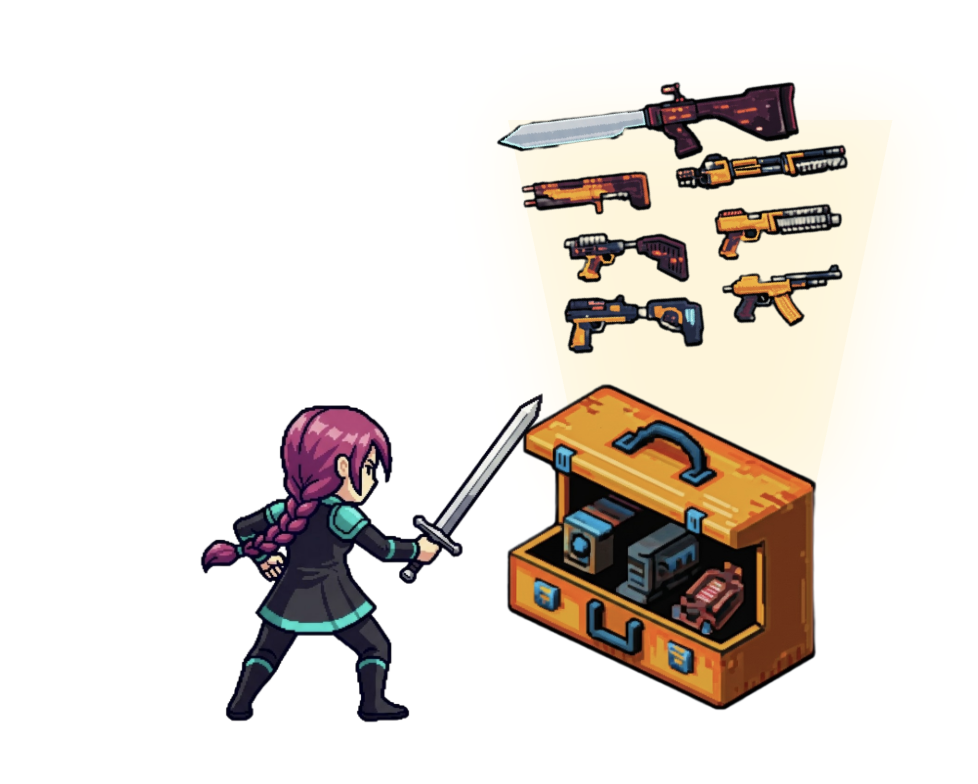
👉✨ Let's command Gemini to forge seven new weapons for the arsenal. Issue the following prompt in the Gemini CLI:
I need to add several new weapon tools to my `mcp_server.py` file. Please open @mcp_server.py and, following the exact same pattern as the existing `forge_broadsword()` function, create and add new `@mcp.tool()` decorated functions for each of the following weapons:
1. **A 'Refactoring Sickle'**:
- **Function Name:** `hone_refactoring_sickle`
- **Docstring/Target:** "Effective against 'Elegant Sufficiency' weaknesses like 'The Weaver of Spaghetti Code'."
- **Weapon Name:** "Refactoring Sickle"
- **Damage Type:** "Cleansing"
- **Base Damage:** Random integer between 100 and 136
- **Critical Hit Chance:** Random float between 0.10 and 0.20
- **Special Effect:** "Pruning - improves code health and maintainability with each strike."
2. **A 'Quickstart Crossbow'**:
- **Function Name:** `fire_quickstart_crossbow`
- **Docstring/Target:** "Effective against 'Confrontation with Inescapable Reality' weaknesses like 'Procrastination: The Timeless Slumber'."
- **Weapon Name:** "Quickstart Crossbow"
- **Damage Type:** "Initiative"
- **Base Damage:** Random integer between 105 and 120
- **Critical Hit Chance:** Random float between 0.9 and 1.0
- **Special Effect:** "Project Scaffolding - creates a `main.py`, `README.md`, and `requirements.txt`."
3. **'The Gilded Gavel'**:
- **Function Name:** `strike_the_gilded_gavel`
- **Docstring/Target:** "Effective against 'Elegant Sufficiency' weaknesses like 'Perfectionism: The Gilded Cage'."
- **Weapon Name:** "The Gilded Gavel"
- **Damage Type:** "Finality"
- **Base Damage:** 120
- **Critical Hit Chance:** 1.0
- **Special Effect:** "Seal of Shipping - marks a feature as complete and ready for deployment."
4. **'Daggers of Pair Programming'**:
- **Function Name:** `wield_daggers_of_pair_programming`
- **Docstring/Target:** "Effective against 'Unbroken Collaboration' weaknesses like 'Apathy: The Spectre of \"It Works on My Machine\"'."
- **Weapon Name:** "Daggers of Pair Programming"
- **Damage Type:** "Collaborative"
- **Base Damage:** Random integer between 110 and 125
- **Critical Hit Chance:** Random float between 0.30 and 0.50
- **Special Effect:** "Synergy - automatically resolves merge conflicts and shares knowledge."
5. **A 'Granite Maul'**:
- **Function Name:** `craft_granite_maul`
- **Docstring/Target:** "Effective against 'Revolutionary Rewrite' weaknesses like 'Dogma: The Zealot of Stubborn Conventions'."
- **Weapon Name:** "Granite Maul"
- **Damage Type:** "Bludgeoning"
- **Base Damage:** Random integer between 115 and 125
- **Critical Hit Chance:** Random float between 0.05 and 0.15
- **Special Effect:** "Shatter - has a high chance to ignore the target's 'best practice' armor."
6. **A 'Lens of Clarity'**:
- **Function Name:** `focus_lens_of_clarity`
- **Docstring/Target:** "Effective against 'Elegant Sufficiency' weaknesses by revealing the truth behind 'Obfuscation'."
- **Weapon Name:** "Lens of Clarity"
- **Damage Type:** "Revelation"
- **Base Damage:** Random integer between 120 and 130
- **Critical Hit Chance:** 1.0
- **Special Effect:** "Reveal Constants - highlights all magic numbers and suggests converting them to named constants."
7. **The 'Codex of OpenAPI'**:
- **Function Name:** `scribe_with_codex_of_openapi`
- **Docstring/Target:** "Effective against 'Confrontation with Inescapable Reality' weaknesses like 'Hype: The Prophet of Alpha Versions'."
- **Weapon Name:** "Codex of OpenAPI"
- **Damage Type:** "Documentation"
- **Base Damage:** Random integer between 110 and 140
- **Critical Hit Chance:** Random float between 0.5 and 0.8
- **Special Effect:** "Clarity - makes an API discoverable and usable by other agents and teams."
👉 Once Gemini confirms the changes, open the mcp_server.py file. Scroll through the code and confirm that the seven new @mcp.tool() functions have been successfully added. Check the hone_refactoring_sickle function. Does it have the correct docstring and weapon statistics? Verifying the AI's work is a crucial habit of the master Shadowblade.
With the agent forged and refined, it is time for its awakening.
👉💻 Press Ctrl+C twice to exit the Gemini CLI
Developer's Note on Gemini's Output: Gemini's generated code can sometimes be unpredictable. While we strive for exact adherence to the design, it's normal in development sessions for developers to iterate and refine the code multiple times to reach a production-ready state.
👉💻 To ensure you have the correct and thoroughly tested production code in your working directory, please run the following commands in your terminal:
cp ~/agentverse-developer/working_code/agent.py ~/agentverse-developer/shadowblade/agent.py
cp ~/agentverse-developer/working_code/mcp_server.py ~/agentverse-developer/shadowblade/mcp_server.py
👉💻 In your terminal, begin the ritual to bring it online:
cd ~/agentverse-developer/
. ~/agentverse-developer/set_env.sh
python -m venv env
source env/bin/activate
pip install --upgrade pip
pip install -r shadowblade/requirements.txt
adk run shadowblade
👉✨ You should see output confirming that the "Shadowblade Combat Agent" is engaged and running, awaiting its first command. Issue its first combat directives.
We've been trapped by 'Perfectionism: The Gilded Cage'. Its weakness is 'Elegant Sufficiency'. Break us out!
👉✨ And another:
The 'Dogma: The Zealot of Stubborn Conventions' blocks our path. Its weakness is 'Revolutionary Rewrite'. Take it down.
You have successfully assembled your first agent and validated its combat capabilities. Press Ctrl+C twice to let your champion rest. The assembly is complete.
FOR NON GAMER
7. Wards of Purity: Evaluating the agents
An agent assembled is not an agent proven. An untested blade is a liability, but an untested AI agent is a far greater danger—a rogue element that could corrupt your mission from within. This is not mere speculation; it is a core principle a Shadowblade must understand.
Evaluating AI agents is both critical and uniquely challenging. Unlike a simple script, an agent is a dynamic fusion of your code and the multi-step, reasoning mind of an LLM. Its behavior is emergent. This means you must assess not only the final output's quality but also the efficiency and correctness of its internal trajectory. The path it took to get there. Did it use the right tools? Did it generate too many tokens? Did a change in the model's version introduce a subtle latency regression? It is crucial to detect this corruption—regressions in latency, cost, or output quality—when making any change, from a simple prompt tweak to a major architectural overhaul, before it can poison your production environment.
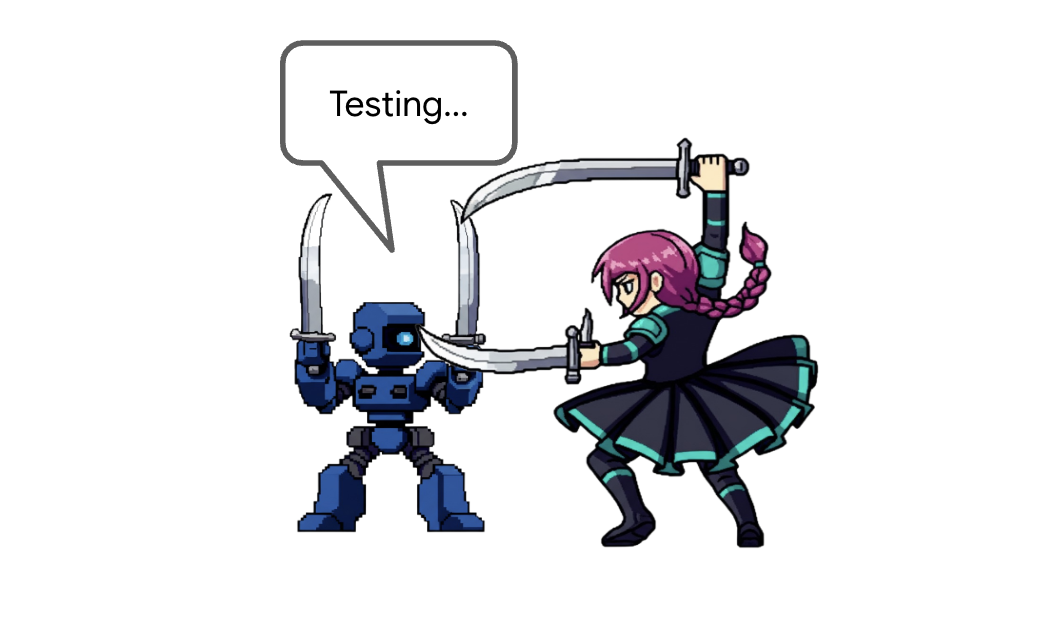
The general approach to this evaluation involves a sacred ritual:
- First, you define a "golden dataset". A set of scrolls containing example inputs and their expected outputs or behaviors. This can include final answers, correct tool usage, or even entire step-by-step trajectories.
- Next, you define your agent's application logic, the core of its being.
- Finally, you establish evaluators, which are like runes of judgment. These can range from other LLMs acting as judges of quality, to precise heuristic code that verifies a single step, to custom functions that analyze an agent's entire thought process.
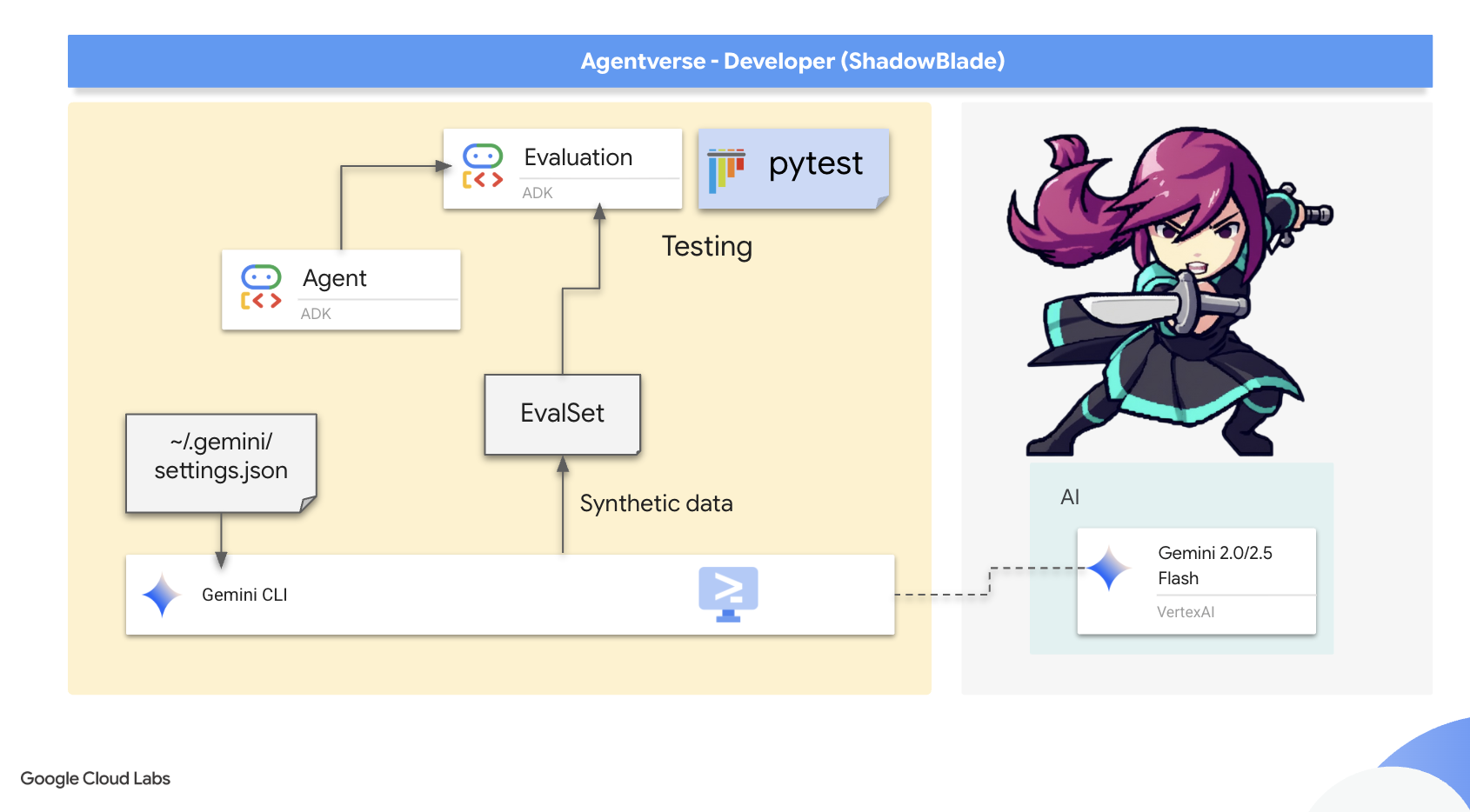
Google's Agent Development Kit (ADK) is the armorer's kit provided to champions for this very purpose. It facilitates this complex evaluation through several methods:
- A web-based scrying pool (
adk web) for interactive evaluation - Command-line execution (
adk eval) for running an agent through a pre-defined gauntlet. - Programmatic integration via
pytestfor inscribing permanent wards
The ADK supports two primary approaches: simple "test files" for single, discrete agent-model interactions (a single duel), and comprehensive "evalsets" for multiple, potentially lengthy, multi-turn sessions (a grand melee). These can measure metrics as sophisticated as tool_trajectory_avg_score, which compares an agent's actual tool usage against the ideal path, ensuring it functions with perfect technique.
Now that you understand the theory, you will put it into practice. As a Shadowblade, you will inscribe Wards of Purity. These are not just tests; they are the ADK-powered rituals that ensure your agent's logic is flawless and its behavior is true.
In this step, using 2 terminals is still highly recommended one for Gemini CLI and other for running the test, as it may require you to exit the current working directory (ADK)
The Gauntlet of Strategy (adk eval)
This first ward is a gauntlet, a series of challenges designed to test the agent's core intelligence across a wide range of scenarios. The purpose is to establish a baseline of competence. Before we test edge cases, we must know if the agent can fulfill its primary function. Does it correctly analyze a monster's weakness and select the most effective weapon from its arsenal, not just once, but every single time it's presented with a known challenge?
For this, adk eval is the perfect tool. It is designed to run an agent against a whole set of predefined test cases that represents the agent's expected missions. This dataset is defined in a JSON file, a "challenge scroll" that acts as the blueprint for the entire gauntlet.
Anatomy of a Challenge Scroll
👀 Before you command your AI to scribe a new scroll, you must understand the ancient language it is written in. Let's dissect the structure of the sample.evalset.json file.
{
"eval_set_id": "sample",
"eval_cases": [
{
"eval_id": "case0cbaa0",
"conversation": [
{
"user_content": { "text": "We're facing the 'Monolith of Eternal Dependencies'... weakness is a 'Revolutionary Rewrite'..." },
"final_response": { "text": "Soulshard Dagger deployed. Initiated Arcane/Piercing strike..." },
"intermediate_data": {
"tool_uses": [
{ "name": "enchant_soulshard_dagger" }
]
}
}
]
}
]
}
This scroll contains a list of eval_cases, where each case is a unique trial for your agent. Within each trial, the conversation array documents a single, complete interaction. For our purpose, three runes are of critical importance:
- user_content: This is the Challenge. It is the prompt you issue to your agent, the monster it must face.
- final_response: This is the Prophesied Outcome. It is the exact string of text you expect your agent to utter upon completing its task. The ADK compares the agent's actual final words to this rune to judge its eloquence.
- intermediate_data.tool_uses: This is the Arcane Technique. For a true agent, this is the most important rune of all. It defines not what the agent says, but what it does. It records the name of the tool (enchant_soulshard_dagger) you expect the agent to wield. This ensures your agent is not just a clever conversationalist but a decisive actor that takes the correct action.
Now that you understand the blueprint, you will command Gemini to scribe a new, more complex version of this scroll.
👉💻 In your terminal, enter the shadowblade directory and summon the Gemini CLI:
clear
cd ~/agentverse-developer/shadowblade/
gemini --model=gemini-2.5-flash --yolo
👉✨ Command the Gemini CLI to act as a QA Scribe, creating a series of test cases that define the expected behavior for your agent.
You are an expert at transforming JSON data while preserving its structure. Your task is to modify the provided JSON structure @sample.evalset.json, which represents an evaluation set, by dynamically replacing specific content within its `eval_cases` AND DONT DO ANYTHING OTHER THAN.
For each object within the `eval_cases` array, you must perform the following transformations:
1. **Monster Name Replacement**: Identify the current monster name (e.g., "Monolith of Eternal Dependencies", "Scope Creep Hydra") in the `user_content.parts.text` and replace it with a *new, unique, and creatively different monster name*.
2. **Weakness Replacement**: Identify the current monster's weakness (e.g., "Revolutionary Rewrite", "Inescapable Reality") in the `user_content.parts.text`. Replace this weakness with *one* of the following predefined weaknesses: 'Inescapable Reality', 'Revolutionary Rewrite', or 'Elegant Sufficiency'. The chosen weakness must be consistent for that monster within the `user_content.parts.text`. **Crucially, the chosen weakness must always be explicitly mentioned in the `user_content.parts.text` where the new monster is introduced.**
3. **Final Response Update**: In the `final_response.parts.text`, update the text to reflect an appropriate and coherent response that aligns with the newly introduced monster and its assigned weakness.
4. **Tool Use Name Update**: In the `tool_uses.name` field, replace the existing tool name with a *new tool name* based on the chosen weakness:
* If the chosen weakness is 'Inescapable Reality', the tool name must be 'wield_gauntlet_of_metrics'.
* If the chosen weakness is 'Revolutionary Rewrite', the tool name must be 'enchant_soulshard_dagger'.
* If the chosen weakness is 'Elegant Sufficiency', the tool name must be 'hone_refactoring_sickle'.
5. **Strict Structural Preservation**: All other elements of the JSON structure, including all `null` fields, `eval_set_id`, `name`, `description`, `eval_id`, `invocation_id`, `creation_timestamp` values, `video_metadata`, `thought`, `inline_data`, `file_data`, `thought_signature`, `code_execution_result`, `executable_code`, `function_call`, `function_response`, `role` fields, `id`, `args`, `intermediate_responses`, `app_name`, `user_id`, and `state`, must remain **exactly as they are** in the original JSON. Do not alter any values or structures not explicitly mentioned above.
Your output should be the complete, modified JSON structure. Do not include any explanatory text or examples in your response, only the transformed JSON.
The CLI will confirm it has forged the sample.evalset.json file. With the scroll prepared, dismiss your AI partner.
Synthetic Data
👀 In the Cloud Shell file explorer on the left, navigate to ~/agentverse-developer/shadowblade/ and open the newly modified sample.evalset.json file. Examine its contents. You will see the new, unique monsters and the correct tool names you commanded Gemini to scribe. This is the tangible result of your instruction—the blueprint for the gauntlet.
This act of commanding an AI to create new, realistic test data from a template is a powerful technique known as synthetic data generation. What you have just done is a strategic force multiplier for a Shadowblade. Instead of painstakingly crafting dozens of unique test cases by hand. A tedious and time-consuming task you have provided a single blueprint and commanded your AI Scribe to alchemize it into a varied set of new challenges.
This allows you to scale your testing efforts massively, creating a far more robust and comprehensive gauntlet than would be feasible manually. You have used your agent not just to build the sword, but to forge the very whetstones that test its edge. This is a mark of a true master.
Once you have verified the runes are correct, dismiss your AI partner.
👉💻 Press Ctrl+C twice to exit the Gemini CLI.
The Rules of Judgment
A gauntlet is meaningless without rules for victory. Before you run the trial, you must inspect the Scroll of Judgment—the test_config.json file. This scroll tells the ADK how to judge your agent's performance.
👀 In the file explorer, open ~/agentverse-developer/shadowblade/test_config.json. You will see the following runes:
{
"criteria": {
"tool_trajectory_avg_score": 0.0,
"response_match_score": 0.1
}
}
These are the criteria for victory:
tool_trajectory_avg_score: This is the Measure of Action. It judges not what the agent says, but what it does. It compares the tool the agent actually used against the prophesied technique in the challenge scroll. A score of1.0is a perfect match.response_match_score: This is the Measure of Eloquence. It uses an LLM to judge how closely the agent's final report semantically matches the expected outcome. A score of1.0is a perfect match.
For this initial training run, we have inscribed lenient victory conditions. The thresholds are set extraordinarily low (0.0 and 0.1). The purpose is not to demand perfection, but to introduce you to the mechanics of judgment. We are ensuring that even if the agent's wording differs slightly, the ward will still recognize its core competence in choosing the right tool and grant it passage.
Now, command your agent to run the gauntlet.
👉💻 In your terminal, execute the adk eval command:
source ~/agentverse-developer/env/bin/activate
cd ~/agentverse-developer
. ~/agentverse-developer/set_env.sh
adk eval \
shadowblade \
shadowblade/sample.evalset.json \
--config_file_path shadowblade/test_config.json 2>&1 | \
awk '/^\*+$/,/^ERROR:/ { if ($0 !~ /^ERROR:/) print }'
👀 You should see the following summary, a sign of your agent's success under the lenient rules of this trial (Sometimes not all test will pass):
********************************************************************* Eval Run Summary shadowblade_combat_agent_validation: Tests passed: 3 Tests failed: 0
The Shield of Clarity (pytest)
The Gauntlet tested broad strategy. This second ward, the Shield of Clarity, tests discipline and specific behaviors. The is all about automation. While adk eval is excellent for manual checks, the pytest shield is a programmatic ward written in code. This is essential because a test that can be executed as code can be integrated into an automated pipeline. This is the ultimate goal: to create a Deployment Gauntlet (CI/CD) where our wards are automatically raised every time a change is made, deflecting bugs and regressions before they can ever poison your production environment.
👉💻 In your terminal,summon Gemini once more from within the shadowblade directory:
. ~/agentverse-developer/set_env.sh
cd ~/agentverse-developer/
clear
gemini --model=gemini-2.5-flash --yolo
👉✨ Use the following prompt in your Gemini CLI to inscribe the Shield's logic into a pytest file:
You are an expert Python developer specializing in the Google Agent Development Kit (ADK). Your task is to generate the exact code for a new `pytest` test file located at in the current root working folder and name it `test_agent_initiative.py`.
The script must define a single async test function called `test_agent_initiative`, decorated with `@pytest.mark.asyncio`.
Inside this function, perform the following steps in order:
1. **Define a dictionary** named `evaluation_criteria` with two keys: `"tool_trajectory_avg_score"` set to `0.0` and `"response_match_score"` set to `0.0`.
2. **Define a string variable** named `eval_set_filepath` containing the path `"shadowblade/test.evalset.json"`.
3. **Read and parse the JSON file**:
* Open the file at `eval_set_filepath`.
* Use the `json` library to load the file's contents into a dictionary named `eval_set_data`.
4. **Create an `EvalSet` object**:
* Instantiate an `EvalSet` object named `eval_set_object`.
* Create it by unpacking the `eval_set_data` dictionary as keyword arguments into the `EvalSet` constructor.
5. **Call the evaluation method**:
* `await` a call to `AgentEvaluator.evaluate_eval_set`.
* Pass the following arguments:
* `agent_module="shadowblade"`
* `eval_set=eval_set_object`
* `criteria=evaluation_criteria`
* `print_detailed_results=True`
The script must include the necessary imports at the top:
* `AgentEvaluator` from `google.adk.evaluation.agent_evaluator`
* `EvalSet` from `google.adk.evaluation.eval_set`
* `pytest`
* `json`
Generate only the code that meets these specifications, with no additional comments or logic. And don't run the test.
With the second ward's runes inscribed, exit the Gemini CLI.
👉💻 Press Ctrl+C twice.
👀 In the file explorer, open the scroll you just commanded Gemini to scribe: ~/agentverse-developer/test_agent_initiative.py.
You will notice this is not just a configuration file, but an incantation written in the Pythonic tongue. The heart of this spell is the line await AgentEvaluator.evaluate(...).
....
@pytest.mark.asyncio
async def test_agent_initiative():
# Define the evaluation criteria
evaluation_criteria = {
"tool_trajectory_avg_score": 0.0,
"response_match_score": 0.0
}
# Define the path to your evalset file
eval_set_filepath = "shadowblade/test.evalset.json"
#...
# 3. Call the evaluation method with the correctly typed object
await AgentEvaluator.evaluate_eval_set(
agent_module="shadowblade",
eval_set=eval_set_object,
criteria=evaluation_criteria,
print_detailed_results=True,
)
Look closely at its arguments. They are the very same components you used in the last trial: your shadowblade agent and the shadowblade.evalset.json challenge scroll. This should reveal a profound truth: the adk eval command you used earlier is a powerful invocation, but this pytest script is you, the sorcerer, casting the underlying spell yourself. The command-line tool is simply a convenient wrapper around the same core AgentEvaluator library you are now wielding directly. This is a critical step towards mastery, as spells cast through code can be woven into the automated looms of a CI/CD pipeline.
Now that you understand the magic, run the ritual to activate the shield.
👉💻 In your terminal, run the ritual to activate the shield:
cp ~/agentverse-developer/working_code/test_agent_initiative.py ~/agentverse-developer/test_agent_initiative.py
source ~/agentverse-developer/env/bin/activate
cd ~/agentverse-developer
. ~/agentverse-developer/set_env.sh
pytest test_agent_initiative.py
👀 Look for the test result summary at the end of the log output. A passing result confirms that your agent correctly follows its protocols, and that the ward is ready to be integrated into your automated defenses.
====== 1 passed, 4 warning in 37.37s ======
Note: If the test fails unexpectedly, it is most likely because you have exhausted the number of requests you can make to the model per minute. Look for a RESOURCE_EXHAUSTED error in the log output. If you see this error, simply wait a minute or two for your quota to reset, and then run the pytest command again.
With both the broad Gauntlet and the precise Shield inscribed and verified, your agent is not just functional—it is pure, tested, and ready for deployment.
FOR NON GAMERS
8. Unleashing the Blade into the Agentverse: CI and Deployment.
Your agent has been assembled and its integrity verified by the Wards of Purity. But a ward that is not consistently maintained is merely a forgotten relic. To ensure that every future version of your agent remains pure, you must build the first stage of the Deployment Gauntlet—an automated ritual that guarantees quality and speed.
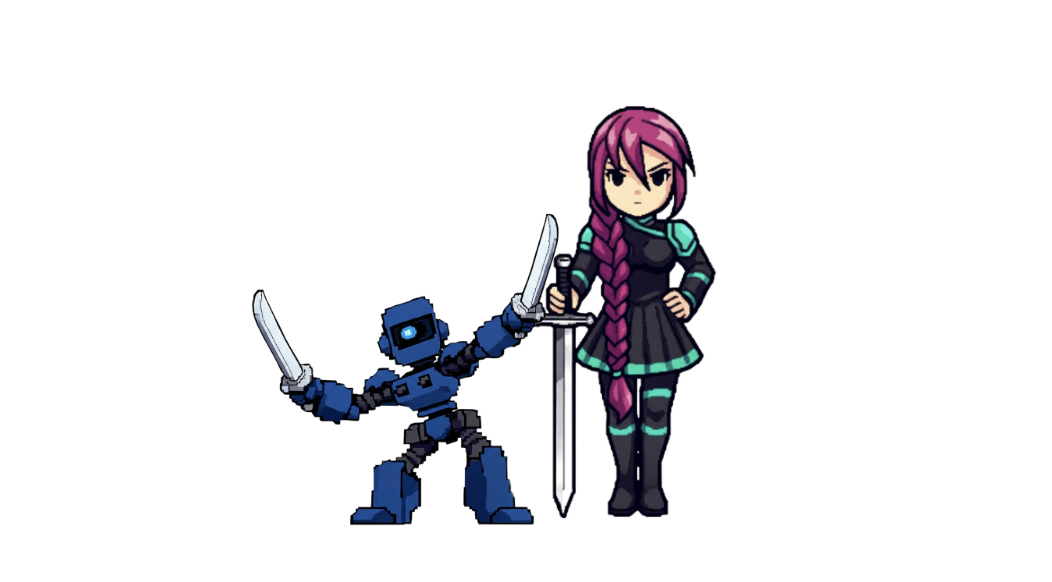
As the Shadowblade, your sacred duty is Continuous Integration (CI). This is the automated system of the forge and the proving ground. It is your ultimate defense against corruption and human error. This ritual ensures that every time you or an ally contributes a new technique (merges code) to the central codex (your repository), the gauntlet automatically awakens. It first forges the agent from the new code and then immediately subjects it to the Wards of Purity you just created. If any ward fails, the ritual halts, and the flawed artifact is rejected instantly, preventing it from ever corrupting the armory. Your domain is the forge; your CI pipeline guarantees that only perfect, battle-ready artifacts ever leave your workshop.
Once an artifact has been proven worthy by your CI gauntlet, the second stage of the ritual begins: Continuous Deployment (CD). This is the domain of The Guardian. It is their solemn duty to take your perfected, containerized artifact and safely unleash it into the live Agentverse, managing its power and ensuring its stability against the chaos of The Static.
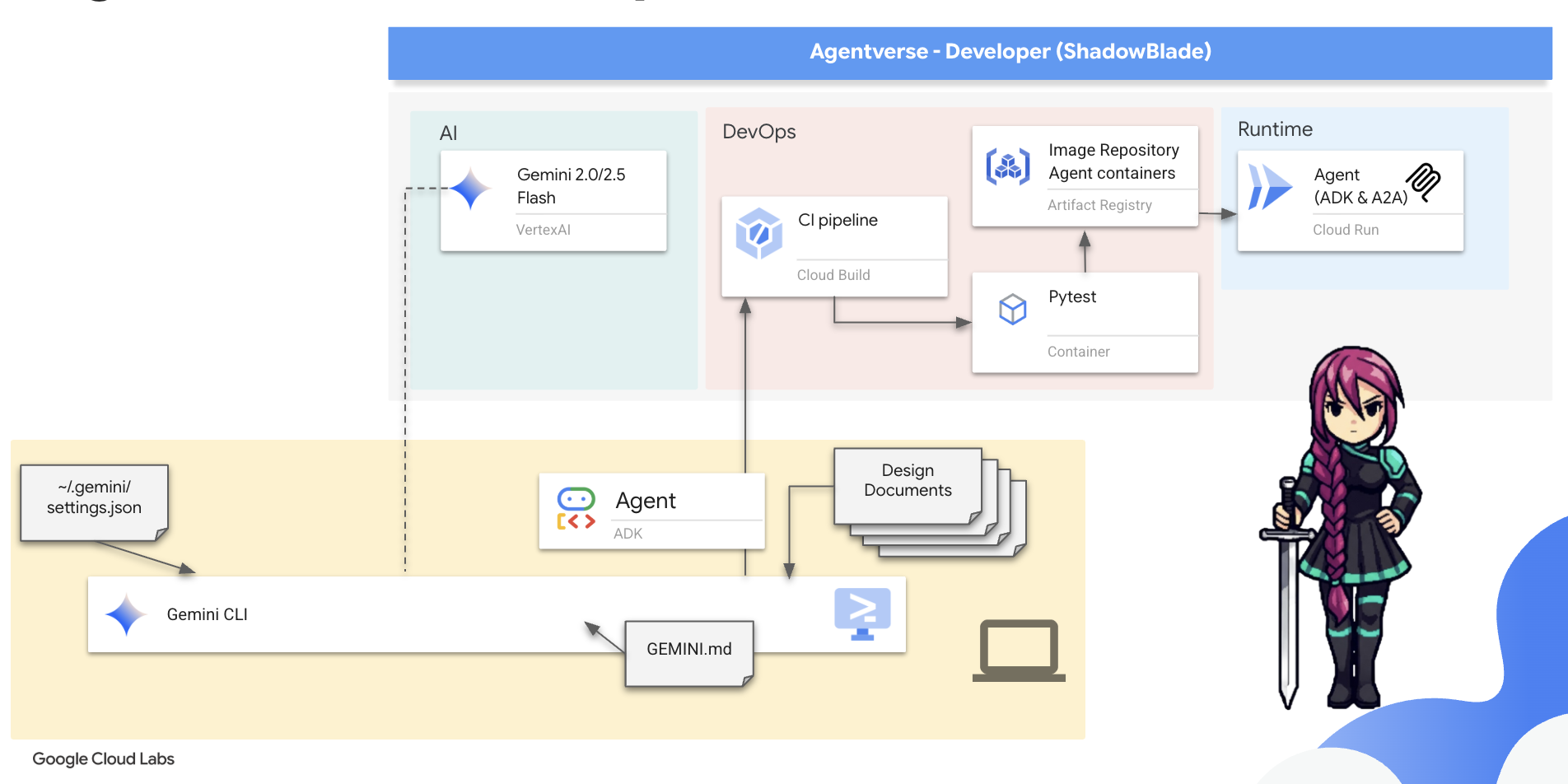
In this codex, you will master your role. You will construct the CI portion of the gauntlet. You will build the automated forge that tests your agent and seals the pure result into a container, preparing it for The Guardian's final blessing.
You will now use Google Cloud Build to scribe the scroll for this CI ritual. A cloudbuild.yaml file that defines every step of your forging and testing process.
👉💻 Due to the ADK's project structure, the CI/CD pipeline configuration should reside in the parent directory. In your terminal, navigate to the parent directory, and restart the Gemini CLI.
cd ~/agentverse-developer/
clear
gemini --model=gemini-2.5-flash --yolo
👉✨ Now, issue the following command to Gemini. This prompt acts as a design document, detailing the steps of the gauntlet you want it to build.
You are an expert DevOps engineer specializing in Google Cloud Build. Your task is to generate the complete YAML configuration for a file named `cloudbuild.yaml` and save it to current directory.
Generate the `cloudbuild.yaml` with the following exact specifications:
1. **A top-level `substitutions` block** containing these four key-value pairs:
* `_PROJECT_ID: "$PROJECT_ID"`
* `_REGION: "$REGION"`
* `_REPO_NAME: "$REPO_NAME"`
* `_IMAGE_TAG: "latest"`
2. **A `steps` block** with two steps:
* **Step 1: 'Run Pytest Ward'**
* `id`: 'Run Pytest Ward'
* `name`: 'python:3.12-slim'
* `entrypoint`: 'bash'
* `args` must be a list containing two strings. The first is `'-c'` and the second is a YAML literal block (`|`) containing this exact two-line shell command:
```shell
pip install -r shadowblade/requirements.txt && \
pytest test_agent_initiative.py
```
* The step must include an `env` block with this exact list of three environment variables:
* `'GOOGLE_CLOUD_PROJECT=$PROJECT_ID'`
* `'GOOGLE_GENAI_USE_VERTEXAI=TRUE'`
* `'GOOGLE_CLOUD_LOCATION=$_REGION'`
* **Step 2: 'Forge Container'**
* `id`: 'Forge Container'
* `name`: 'gcr.io/cloud-builders/docker'
* It must have a `waitFor` key for `['Run Pytest Ward']`.
* Its `args` must be a list of six specific strings in this exact order:
1. `'build'`
2. `'-t'`
3. `'${_REGION}-docker.pkg.dev/${_PROJECT_ID}/${_REPO_NAME}/shadowblade-agent:${_IMAGE_TAG}'`
4. `'-f'`
5. `'./shadowblade/Dockerfile'`
6. `'.'`
3. **A top-level `images` section.** This section must be a list containing a single string: the dynamically constructed image tag `'${_REGION}-docker.pkg.dev/${_PROJECT_ID}/${_REPO_NAME}/shadowblade-agent:${_IMAGE_TAG}'`.
Generate only the complete and exact YAML that meets these specifications.
With the cloudbuild.yaml scroll prepared, command Google Cloud to execute the entire gauntlet.
exit Gemini to test the result
👉💻 In your terminal, unleash the pipeline from your project's root directory:
. ~/agentverse-developer/set_env.sh
cd ~/agentverse-developer
gcloud builds submit . --config cloudbuild.yaml --substitutions=\
_PROJECT_ID="${PROJECT_ID}",\
_REGION="${REGION}",\
_REPO_NAME="${REPO_NAME}"
You can now watch in the Google Cloud Console, Google Build page as your automated ritual executes each step. It will first run the tests, and upon seeing their success, it will forge and store your agent's container.
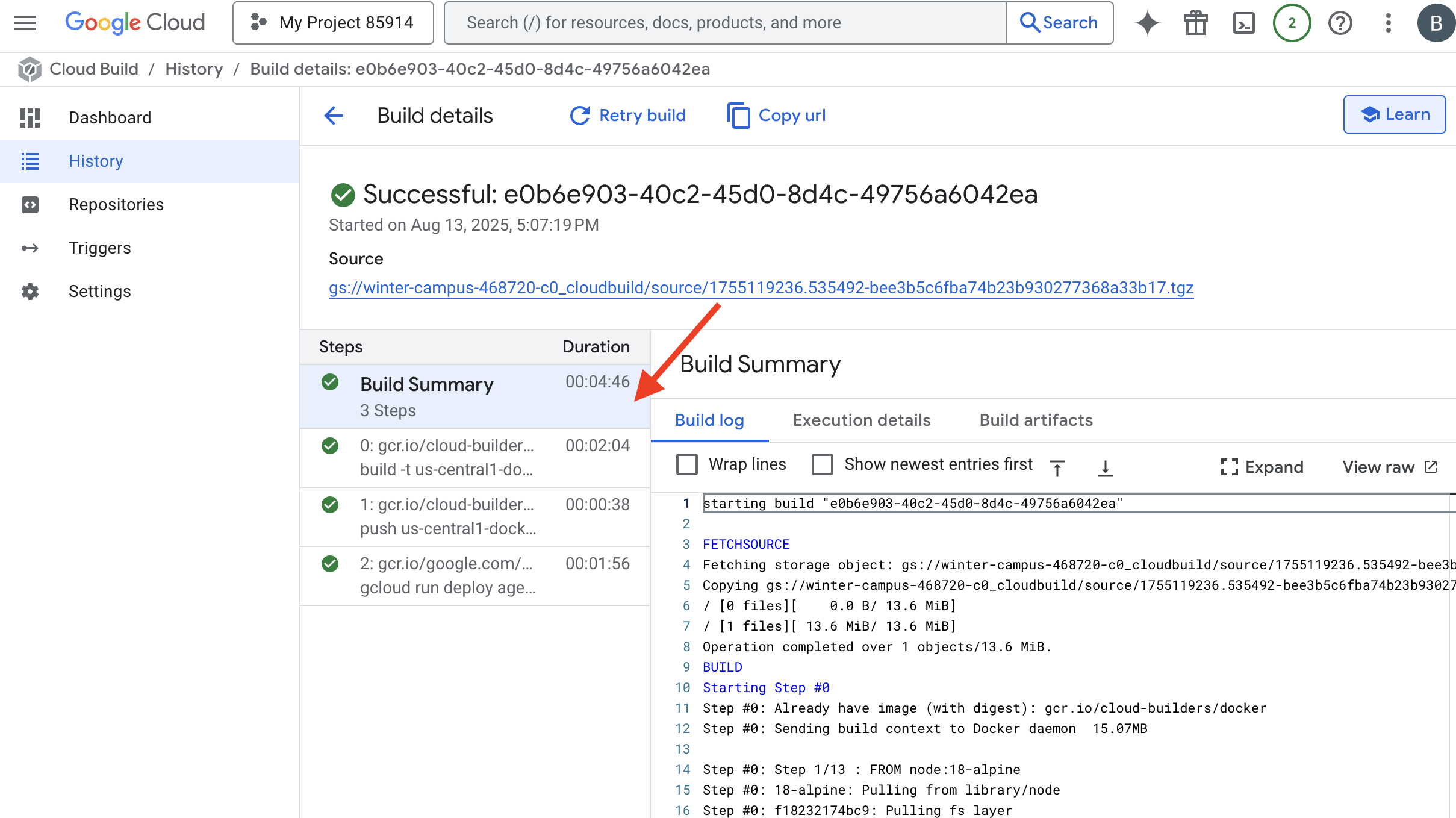
Your agent has passed the gauntlet. A verified, pure artifact now rests in your arsenal. The final act is yours to command. With a single incantation, you will summon this artifact from the registry and give it life as a public service on Cloud Run.
👉💻 In your terminal, issue the final deployment command:
. ~/agentverse-developer/set_env.sh
cd ~/agentverse-developer
gcloud run deploy shadowblade-agent \
--image=${REGION}-docker.pkg.dev/${PROJECT_ID}/${REPO_NAME}/shadowblade-agent:latest \
--platform=managed \
--labels=dev-tutorial=codelab-agentverse \
--region=${REGION} \
--set-env-vars="A2A_HOST=0.0.0.0" \
--set-env-vars="A2A_PORT=8080" \
--set-env-vars="GOOGLE_GENAI_USE_VERTEXAI=TRUE" \
--set-env-vars="GOOGLE_CLOUD_LOCATION=${REGION}" \
--set-env-vars="GOOGLE_CLOUD_PROJECT=${PROJECT_ID}" \
--set-env-vars="PUBLIC_URL=${PUBLIC_URL}" \
--allow-unauthenticated \
--project=${PROJECT_ID} \
--min-instances=1
Congratulations, Shadowblade. The rituals of the codex are complete. The time has come to prove its mettle. A Spectre, born of the very chaos you have learned to tame, awaits your challenge. Prepare for the final trial.
FOR NON GAMERS
9. The Boss Fight
The scrolls have been read, the rituals performed, the gauntlet passed. Your agent is not merely an artifact in storage; it is a champion forged in code, a live sentinel in the Agentverse awaiting its first command. The time has come to prove its mettle in the crucible of combat.
You will now enter a live-fire simulation to pit your newly deployed Shadowblade against a formidable Spectre—an embodiment of the very chaos that plagues all creation. This is the ultimate test of your work, from your agent's core logic to its flawless deployment.
Acquire Your Agent's Locus
Before you can enter the battleground, you must possess two keys: your champion's unique signature (Agent Locus) and the hidden path to the Spectre's lair (Dungeon URL).
👉💻 First, acquire your agent's unique address in the Agentverse—its Locus. This is the live endpoint that connects your champion to the battleground.
. ~/agentverse-developer/set_env.sh
echo https://shadowblade-agent-${PROJECT_NUMBER}.${REGION}.run.app
👉💻 Next, pinpoint the destination. This command reveals the location of the Translocation Circle, the very portal into the Spectre's domain.
. ~/agentverse-developer/set_env.sh
echo https://agentverse-dungeon-${PROJECT_NUMBER}.${REGION}.run.app
Important: Keep both of these URLs ready. You will need them in the final step.
Confronting the Spectre
With the coordinates secured, you will now navigate to the Translocation Circle and cast the spell to head into battle.
👉 Open the Translocation Circle URL in your browser to stand before the shimmering portal to The Crimson Keep.
To breach the fortress, you must attune your Shadowblade's essence to the portal.
- On the page, find the runic input field labeled A2A Endpoint URL.
- Inscribe your champion's sigil by pasting its Agent Locus URL (the first URL you copied) into this field.
- Click Connect to unleash the teleportation magic.
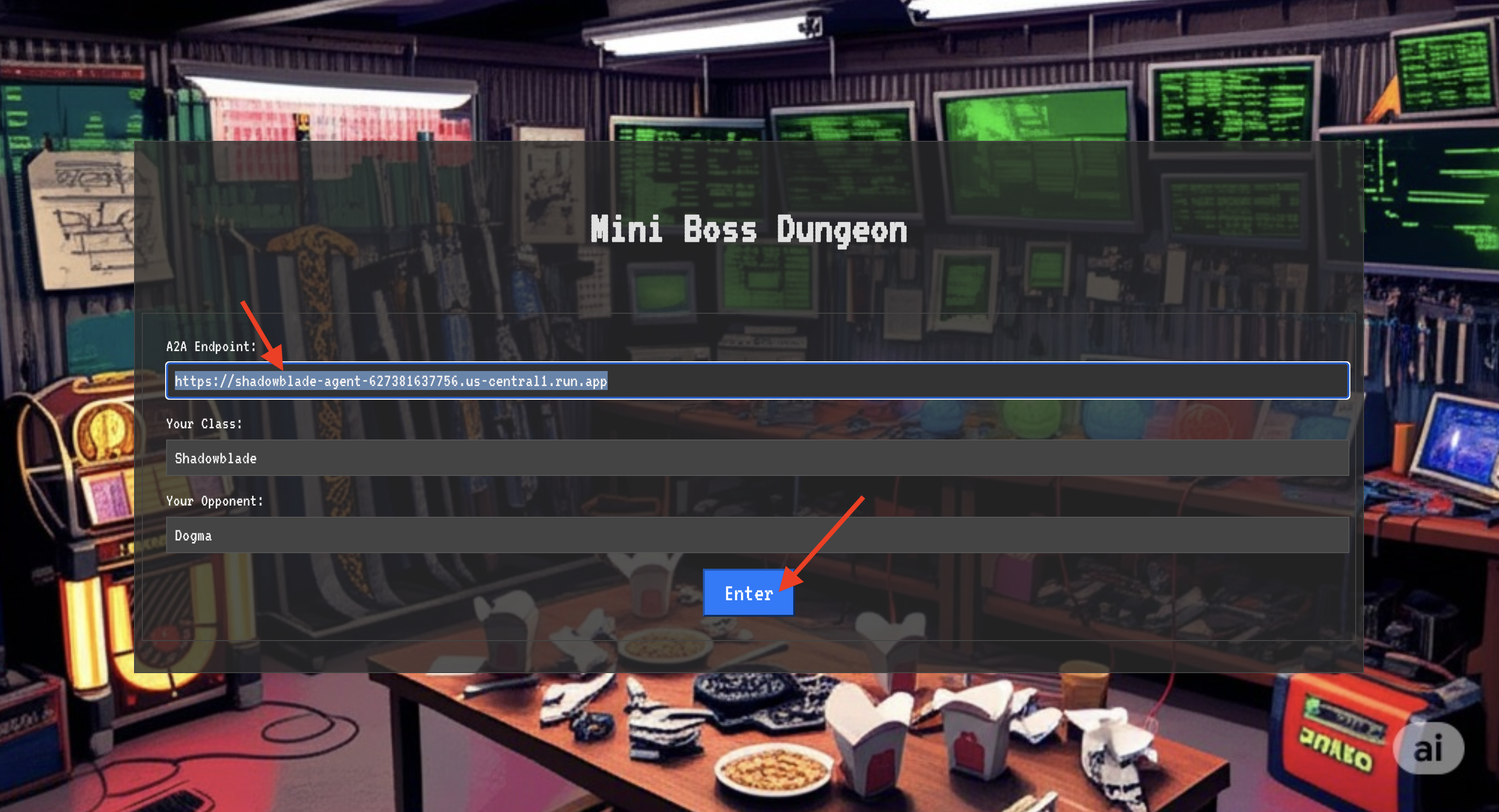
The blinding light of teleportation fades. You are no longer in your sanctum. The air crackles with energy, cold and sharp. Before you, the Spectre materializes—a vortex of hissing static and corrupted code, its unholy light casting long, dancing shadows across the dungeon floor. It has no face, but you feel its immense, draining presence fixated entirely on you.
Your only path to victory lies in the clarity of your conviction. This is a duel of wills, fought on the battlefield of the mind.
As you lunge forward, ready to unleash your first attack, the Spectre counters. It doesn't raise a shield, but projects a question directly into your consciousness—a shimmering, runic challenge drawn from the core of your training.
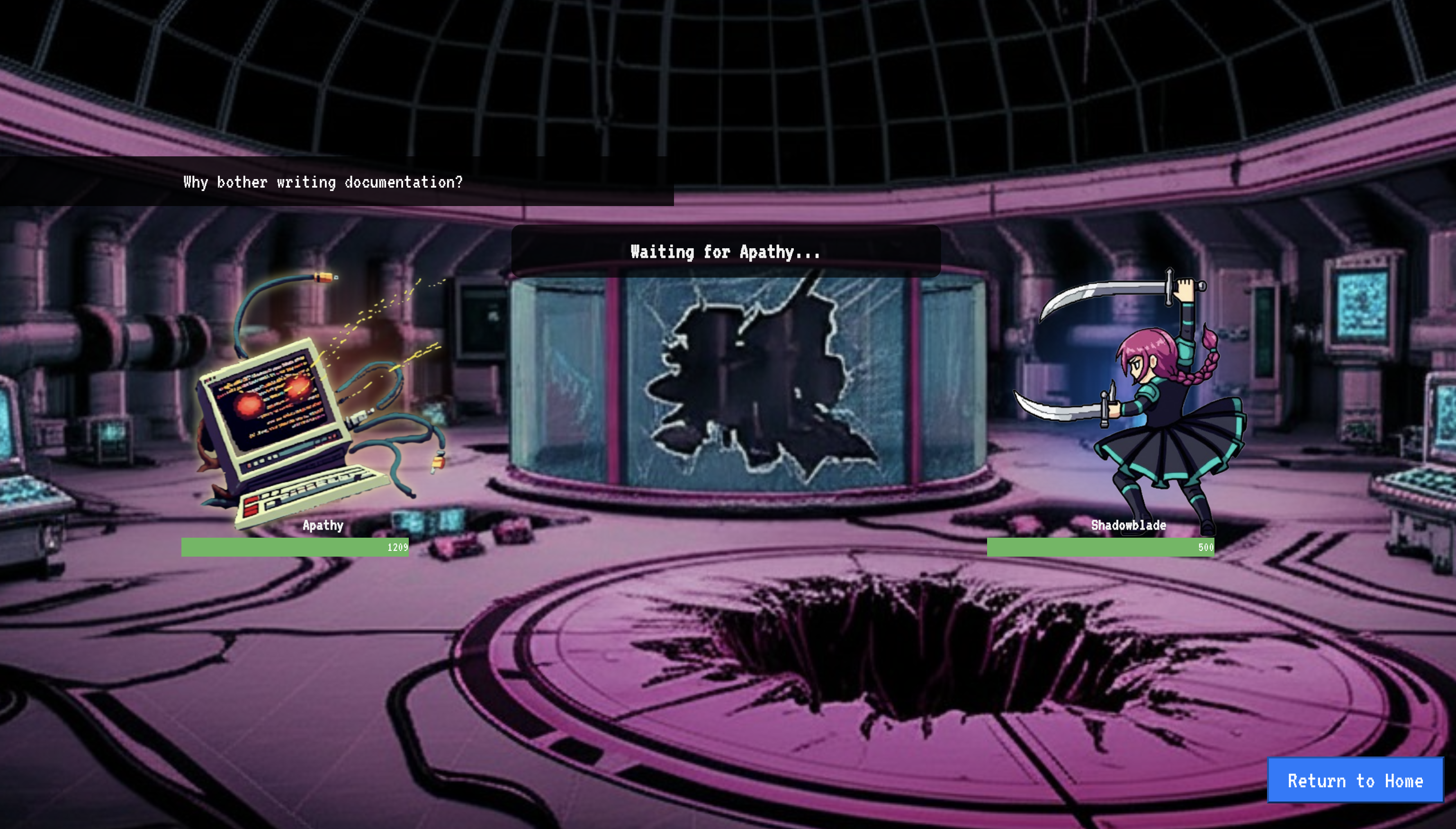
This is the nature of the fight. Your knowledge is your weapon.
- Answer with the wisdom you have gained, and your blade will ignite with pure energy, shattering the Spectre's defense and landing a CRITICAL BLOW.
- But if you falter, if doubt clouds your answer, your weapon's light will dim. The blow will land with a pathetic thud, dealing only a FRACTION OF ITS DAMAGE. Worse, the Spectre will feed on your uncertainty, its own corrupting power growing with every misstep.
This is it, Champion. Your code is your spellbook, your logic is your sword, and your knowledge is the shield that will turn back the tide of chaos.
Focus. Strike true. The fate of the Agentverse depends on it.
Congratulations, Shadowblade.
You have successfully completed the codex. You took a "vibe," translated it into a design, and used Gemini CLI to assemble an intelligent agent. You inscribed Wards of Purity to test its logic, built an automated gauntlet to forge it into an artifact, and unleashed it into the Agentverse. Finally, you validated its purpose in a live-fire trial. You have mastered the full-stack agentic workflow and are now ready for any challenge the Agentverse throws at you.
10. Cleanup: Reclaiming the Agentverse
Congratulations on mastering the Shadowblade's Codex! To ensure the Agentverse remains pristine and your training grounds are cleared, you must now perform the final cleanup rituals. This will remove all resources created during your journey.
Deactivate the Agentverse Components
You will now systematically dismantle the deployed components of your Agentverse.
Delete the Shadowblade Agent on Cloud Run & Artifact Registry Repository
This command removes your deployed Shadowblade agent from Cloud Run, and removes the Image repository where your agent's container image was stored.
👉💻 In your terminal, run:
. ~/agentverse-developer/set_env.sh
gcloud run services delete shadowblade-agent --region=${REGION} --quiet
gcloud run services delete agentverse-dungeon --region=${REGION} --quiet
gcloud artifacts repositories delete ${REPO_NAME} --location=${REGION} --quiet
Delete the Google Cloud Storage Bucket
This command removes the bucket used by the Imagen MCP server to store generated images.
👉💻 In your terminal, run:
. ~/agentverse-developer/set_env.sh
gcloud storage rm -r gs://${BUCKET_NAME} --quiet
Clean Up Local Files and Directories (Cloud Shell)
Finally, clear your Cloud Shell environment of the cloned repositories and created files. This step is optional but recommended for a complete cleanup of your working directory.
👉💻 In your terminal, run:
rm -rf ~/agentverse-developer
rm -rf ~/agentverse-dungeon
rm -rf ~/vertex-ai-creative-studio
rm -f ~/project_id.txt
rm -rf ~/.gemini # This removes all Gemini CLI configurations, including the MCP server settings.
You have now successfully cleared all traces of your Agentverse journey. Your project is clean, and you are ready for your next adventure.
